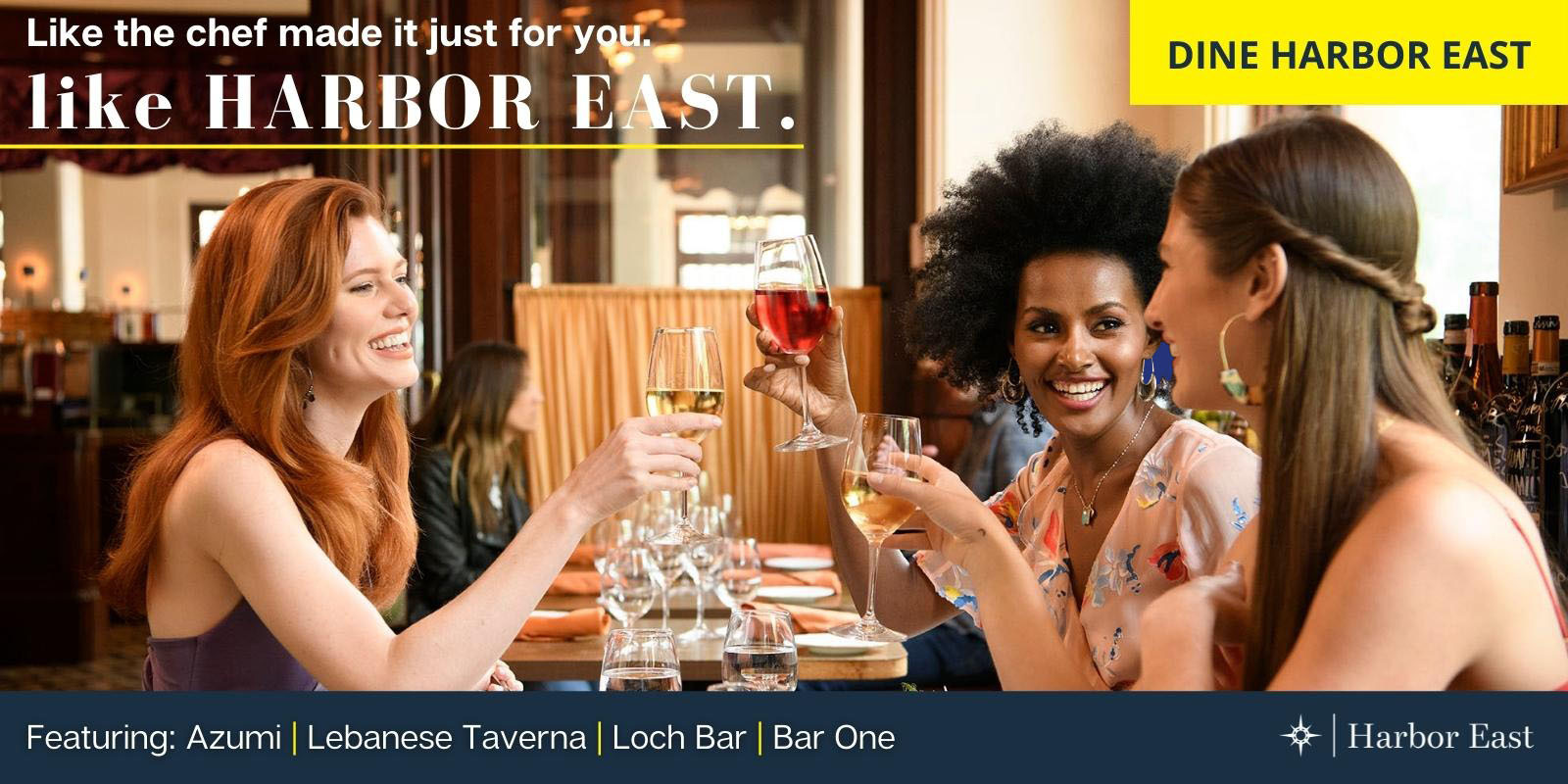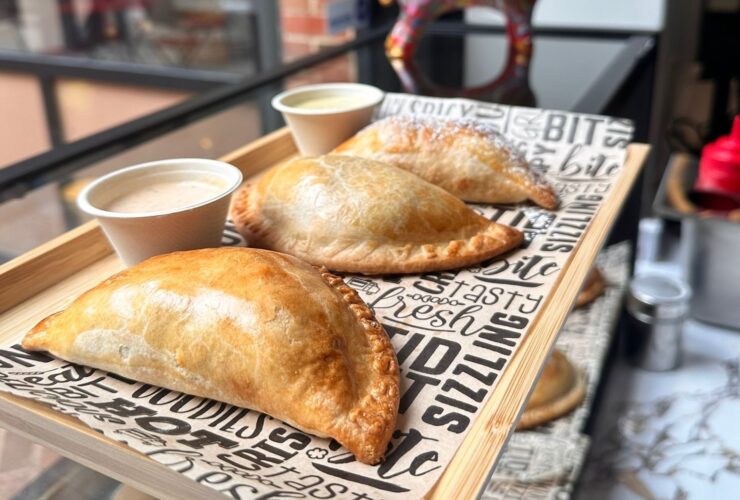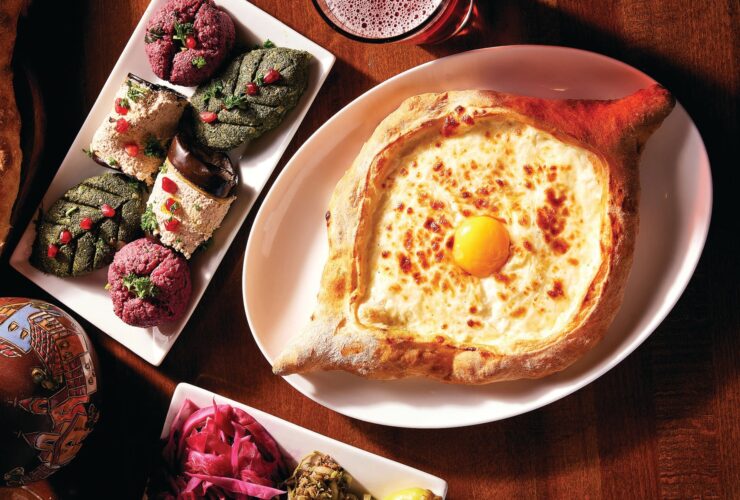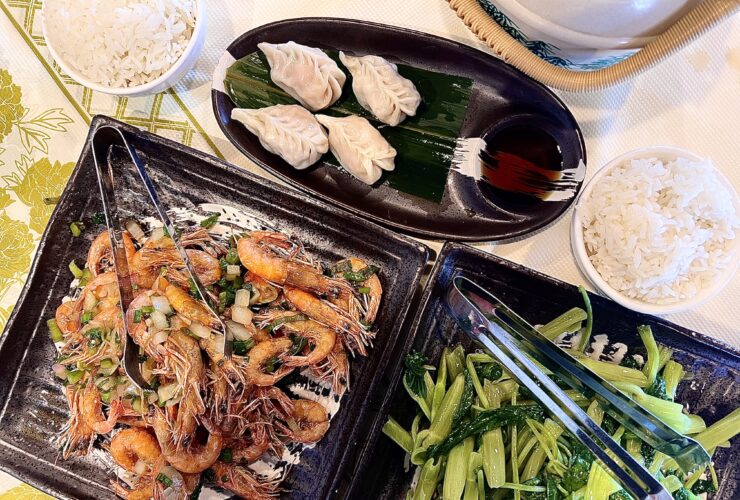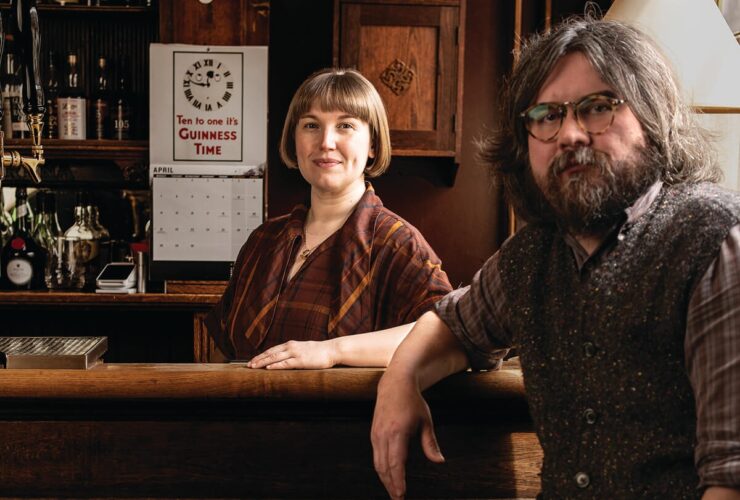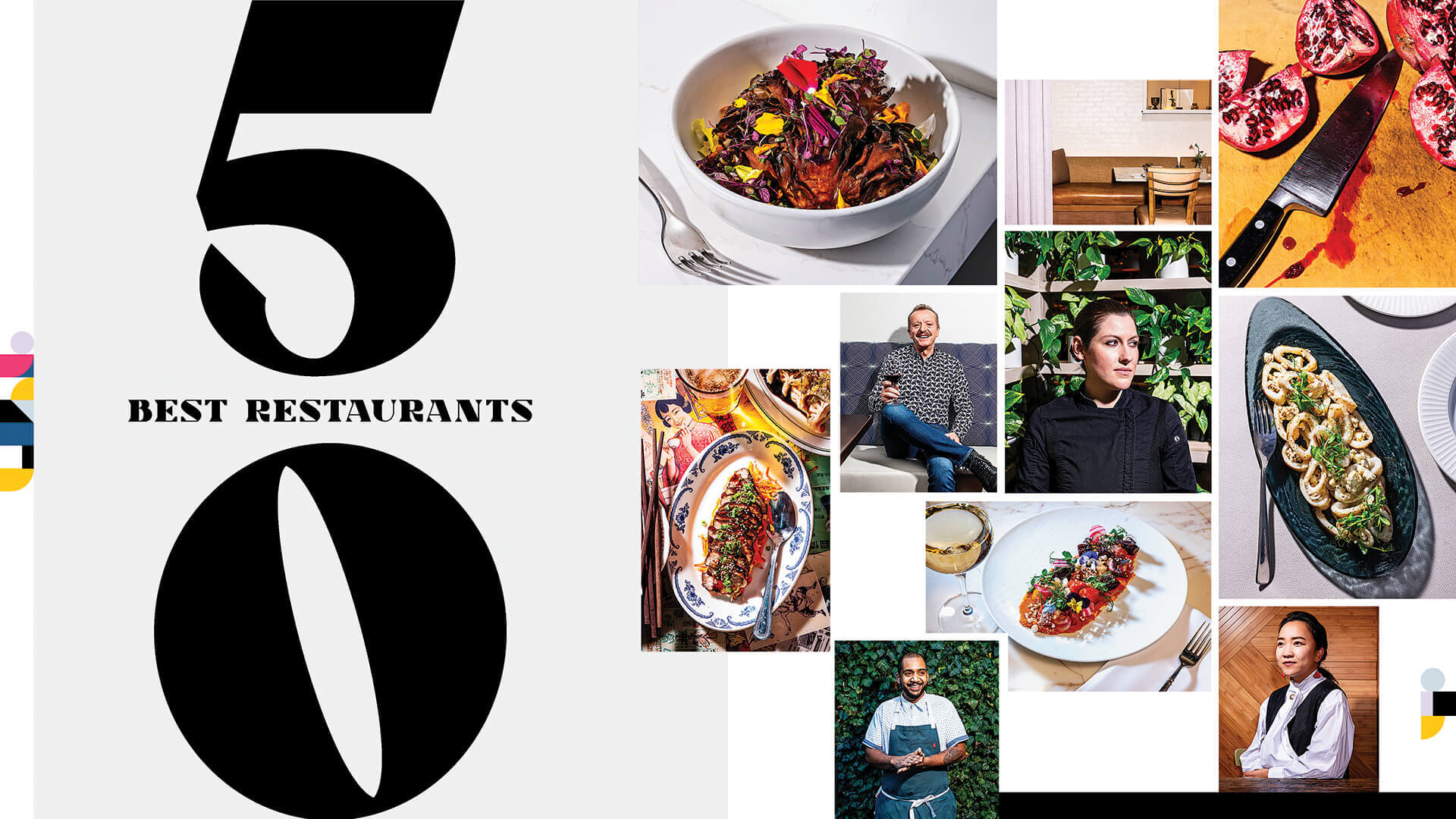
Food & Drink

Edited by Jane Marion
With Suzanne Loudermilk and Mike Unger. Additional reporting by Lauren Cohen and John Farlow
PHOTOGRAPHY BY SCOTT SUCHMAN


THE BEGINNING, that is to say, somewhere around mid-March 2020, this whole cooking-at-home thing didn’t seem so bad. In fact, for a moment there, as the pandemic shut down restaurants for indoor dining and I found myself boiling dough for bagels, investing in online cooking classes (thank you Alice Waters for your “MasterClass” extolling the wonders of California cuisine), indulging in to-go cocktails, and scrolling foodie accounts on Instagram for inspiration, it was actually novel.
But as spring became summer and faded into fall, and another six months went by, I had to accept that I’d never perfect the five basic sauces. And as the exhaustion of the daily grind—that is, the making of every meal—took its toll, I started to dream about dining out again.
Of course, even dining out was no easy feat this year, least of all for those who struggled to keep restaurants afloat. Now, more than ever, I’m in absolute awe of the folks—that’s the chefs, the sous-chefs, the servers, the dishwashers, the busboys, the bartenders, the hosts—who have made their livelihood by working in restaurants. A career in hospitality has never been easy, but for the past two years, it’s been brutal, and many have abandoned it altogether.
When the pandemic hit, and then wore on, I secretly feared that I’d never eat out again, or that I’d forget what the experience was even like. But restaurants adjusted, and so did I. At press time, as life has entered the third or fourth “new normal” phase, I’ve eaten many a meal in plywood parklets decorated with festive flowers and vines, in elaborately erected tents, and in elegant dining rooms, albeit ones with new HVAC and hand sanitation systems installed.
It turns out that eating out is a lot like riding a bike. Once you learn how to do it, you never forget. But I had forgotten the pure pleasure of not only having a professional cook my food, but having someone to serve it. I had forgotten the joy of having an actual sommelier (that is, someone other than my son grabbing a bottle from the basement when I shout, “Can you bring up a bottle of red?”) properly pair a Cabernet with my filet. I had forgotten what a delight it is to have someone else do the clearing and the cleaning and what hard work it is to scrape my old cast-iron skillets and scrub the grease from my oven after setting off the smoke detector.
Fortunately, as pivot after pivot has proven, Baltimore’s restaurant scene is not going anywhere. Yes, it has staggered and stumbled and gasped for survival—but it never stopped. In addition to the tried-and-trues that have, against all odds, endured, amazingly, there have been numerous notable newcomers that have had the chutzpah to open for the first time at the height of the pandemic.
These days, restaurants have a renewed sense of purpose, optimism, and more spirit and spunk than ever. They have never been more inviting, not only because I, and everyone I know, have missed them, but because the restaurants missed us, too, and reopened with fresh resolve. They have created lush, landscaped, outdoor oases, upped their sanitation game, jettisoned menus for QR codes, and raised wages to create more equitable places to work. In these unprecedented times, menus have been pared down due to sourcing issues, rising food costs, and labor shortages, though in some instances that’s also helped raise the quality of everything we eat with the focus on hyper-local.
Yes, restaurateurs have tacked on surcharges at the bottom of the bill to defray pandemic losses and enforced stricter cancellation policies. And yet, even as the pandemic waxes and wanes (and waxes again), diners are turning out in droves, and getting a Saturday night reservation on OpenTable at certain hotspots can be challenging.
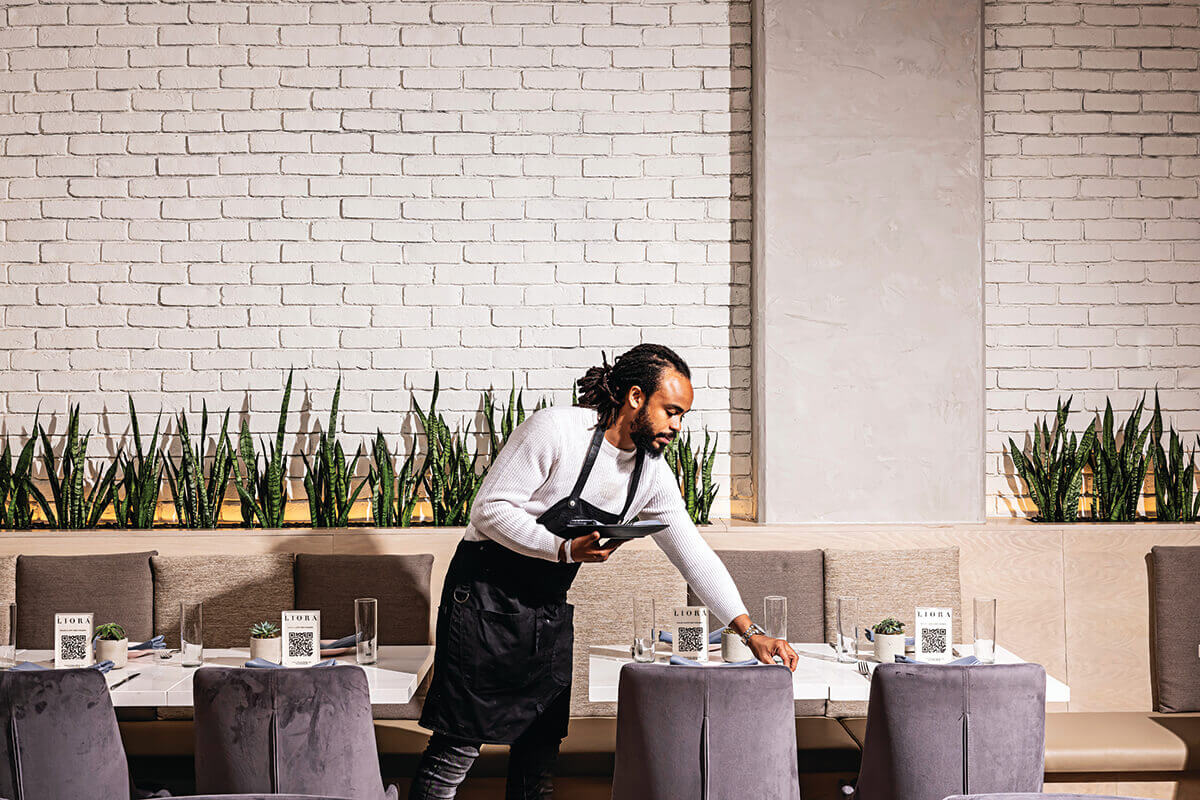
A server prepares for dinner service in the plant-filled dining room at Liora.
Happily, in the state of Maryland, reports of the death of restaurants were greatly exaggerated. Thanks to many measures, from tight state restrictions to high vaccination rates to strict protocol at area spots, the number of closings wasn’t as high as first predicted due to the pandemic, even with this most recent omicron wave.
As of January 2022, 16 percent of all Maryland restaurants had permanently closed, according to Maryland Restaurant Association President Marshall Weston. That’s 1,800 restaurants, which may sound grim, but consider that back in the fall of 2020, Weston had predicted that 35 percent would close. In addition, Charm City’s ever-devoted culinary community supported its favorite restaurants by getting food and cocktails to-go, picking up DIY baskets, and even hiring chefs to host intimate parties at their homes.
Which brings us to this year’s 50 Best Restaurants list, a list we were forced to take a break from last year, as restaurants were forced to take a break from doing business as we know it. But restaurants are back—and beckon more than ever. And this is our tribute to them.
In this new world order, it’s important to acknowledge that a Best Restaurant isn’t a place where everything is perfect. If the pandemic has taught us anything, it’s that life is all about pressing pause to celebrate the good stuff, especially the ordinary things we once took for granted, with the ones we love. A Best Restaurant is a place where we feel like our best selves. A place where, in the company of family or friends, we can bask in the glow of a warm and inviting environment, eat something wonderful, and leave feeling fortified, fueled, and connected. In other words, it’s a place that leaves us feeling more alive than when we first sat down. For one reason or another, each and every one of the restaurants on these pages—from a neighborhood pizza joint to a James Beard Award-nominated fine-dining den to an Argentine steakhouse—does exactly that.
In these uncertain times, one thing is for certain: Eating out is a privilege we will never take for granted again. So, sit back, relax, and enjoy every professionally cooked bite from one of these spots. And remember to tip your server, tag your photos, and shout from the Shot Tower how much you loved your meal. Restaurants have toiled mightily to be here for us.
And kudos to us, the discerning diners, for being here for them.
Alma Cocina Latina
STATION NORTH 1701 North Charles St.
Now in new digs in Station North, this convivial culinary hub serving Venezuelan fare is more delicious than ever—and only serves to strengthen Baltimore’s reputation as a foodie town. Husband-and-wife founders Mark Demshak and Venezuela-born Irena Stein play the role of preeminent hosts, as they warmly greet every guest at the door (and continue to dote once you’re seated). Back in the kitchen, 28-year-old wunderkind chef-partner David Zamudio turns out prettily plated dishes of roast chicken and delectable paella. But his arepas, stuffed South American corncakes, are the stars of the show. We’re especially fond of the La Mariscada version, bursting with grilled octopus, shrimp, and a drizzle of aioli. Zamudio’s food is bold and beautiful—and Baltimore is better for it.
Food for Thought:
Demshak has a master’s degree in architecture from the University of Pennsylvania. Stein was a Fulbright Scholar studying cultural anthropology at Stanford University.
Ananda
FULTON 7421 Maple Lawn Blvd.
When Ananda opened in 2014, it was a spinoff of the iconic Indian restaurant The Ambassador Dining Room, some 25 miles away in Baltimore. Nearly eight years later, owners Keir and Binda Singh have sold The Ambassador, and turned this once-fledgling restaurant into a Howard County icon all its own. Ananda hits all the Best Restaurant high notes. For starters, the art of hospitality is on full display here. The sartorially suited Binda greets every customer with a warm hug or handshake and servers are well-schooled in the nuances of the menu. The ambiance is dark and dramatic—and there’s no such thing as a bad seat, whether you’re perched on the porch with its glowing fireplaces, in the dreamy dining room, or the glorious garden brimming with Mandevillas and pansies. And then there’s the food. The restaurant sources vegetables from its own farm, and the practice of cooking them (and everything else, for that matter) is a family affair. The Singhs’ sister, Kinday, runs the kitchen, where elegant Northern Indian dishes like grilled shrimp adrak served with avocado chutney or fragrant lamb chops cooked in the tandoor are on offer. From the minute you enter, the whole place casts a spell, making every visit memorable.
Food for Thought:
The stained-glass panels in the dining room were pulled from a historic mansion in Bolton Hill.


By Jane Marion
INNER HARBOR 414 Light St.
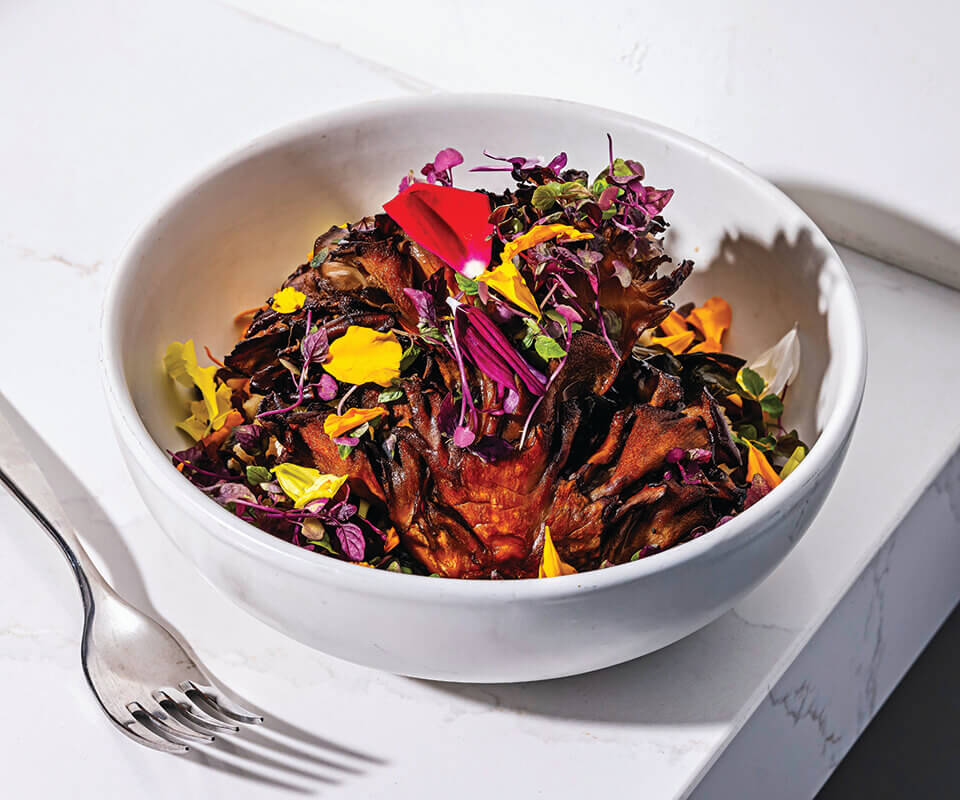
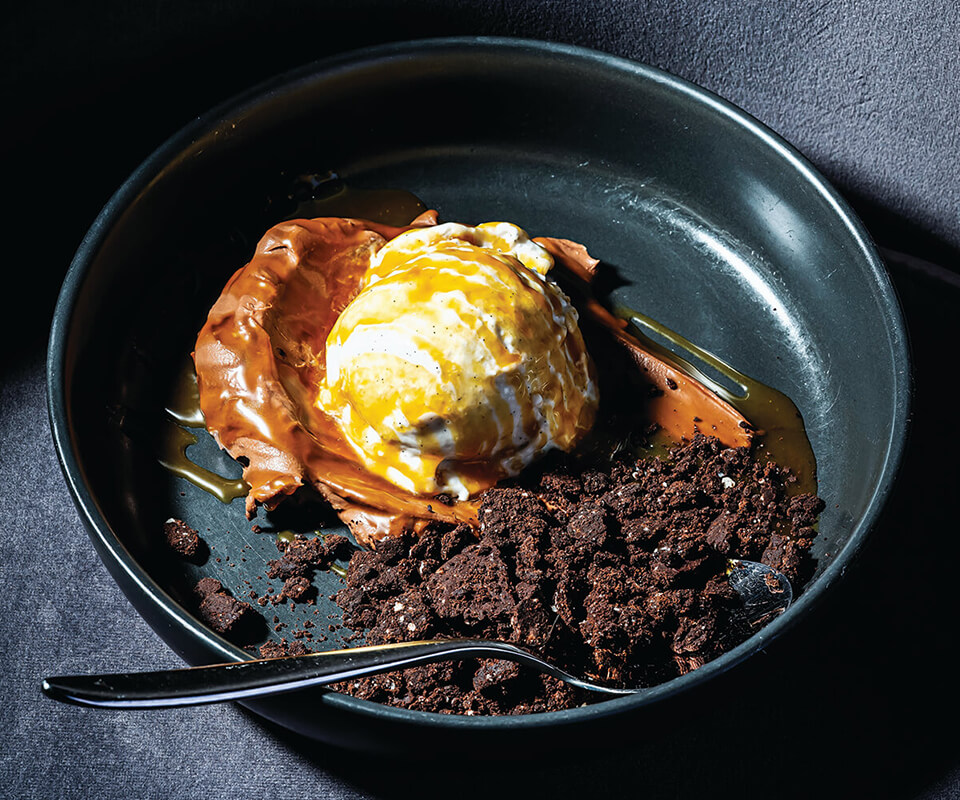
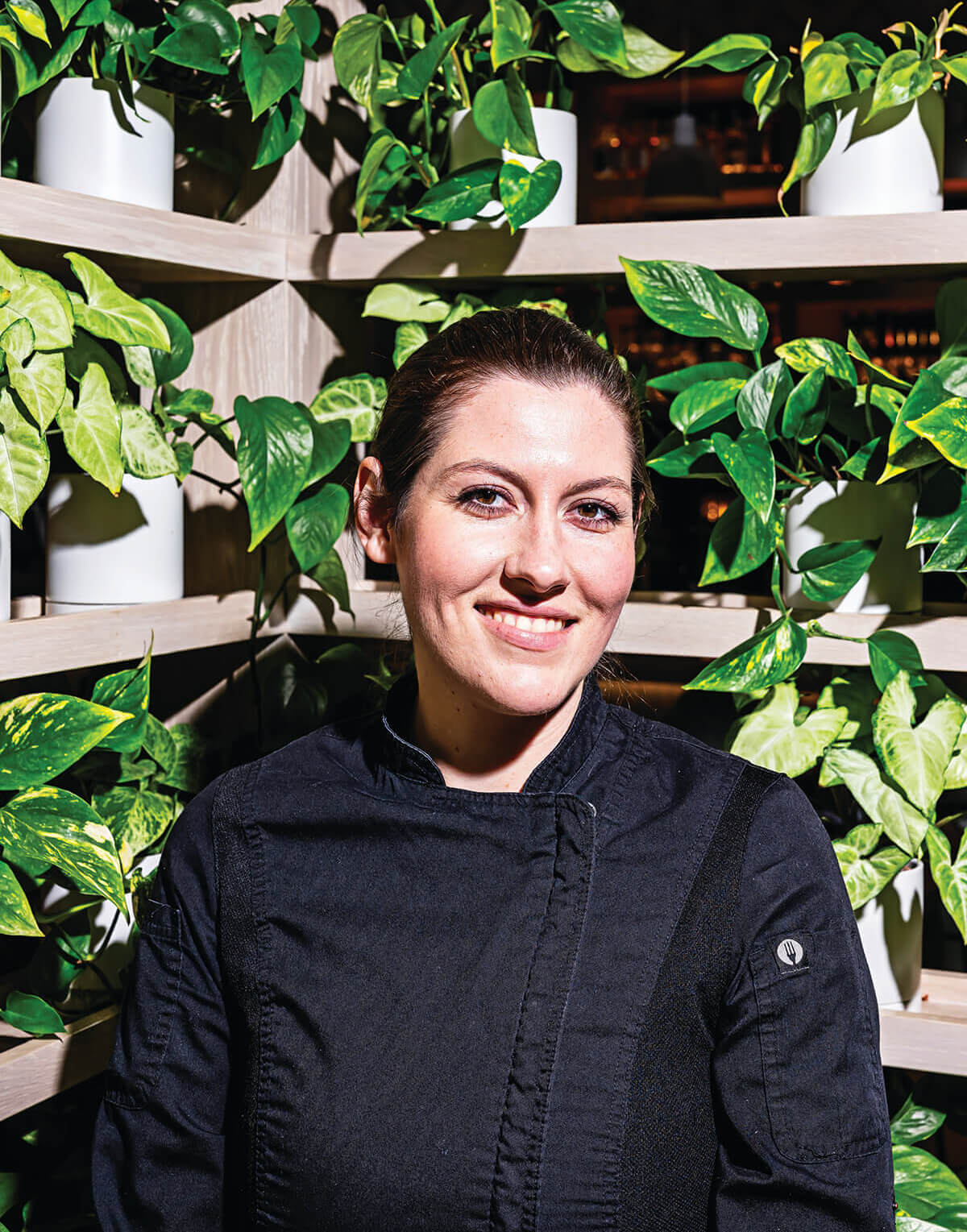
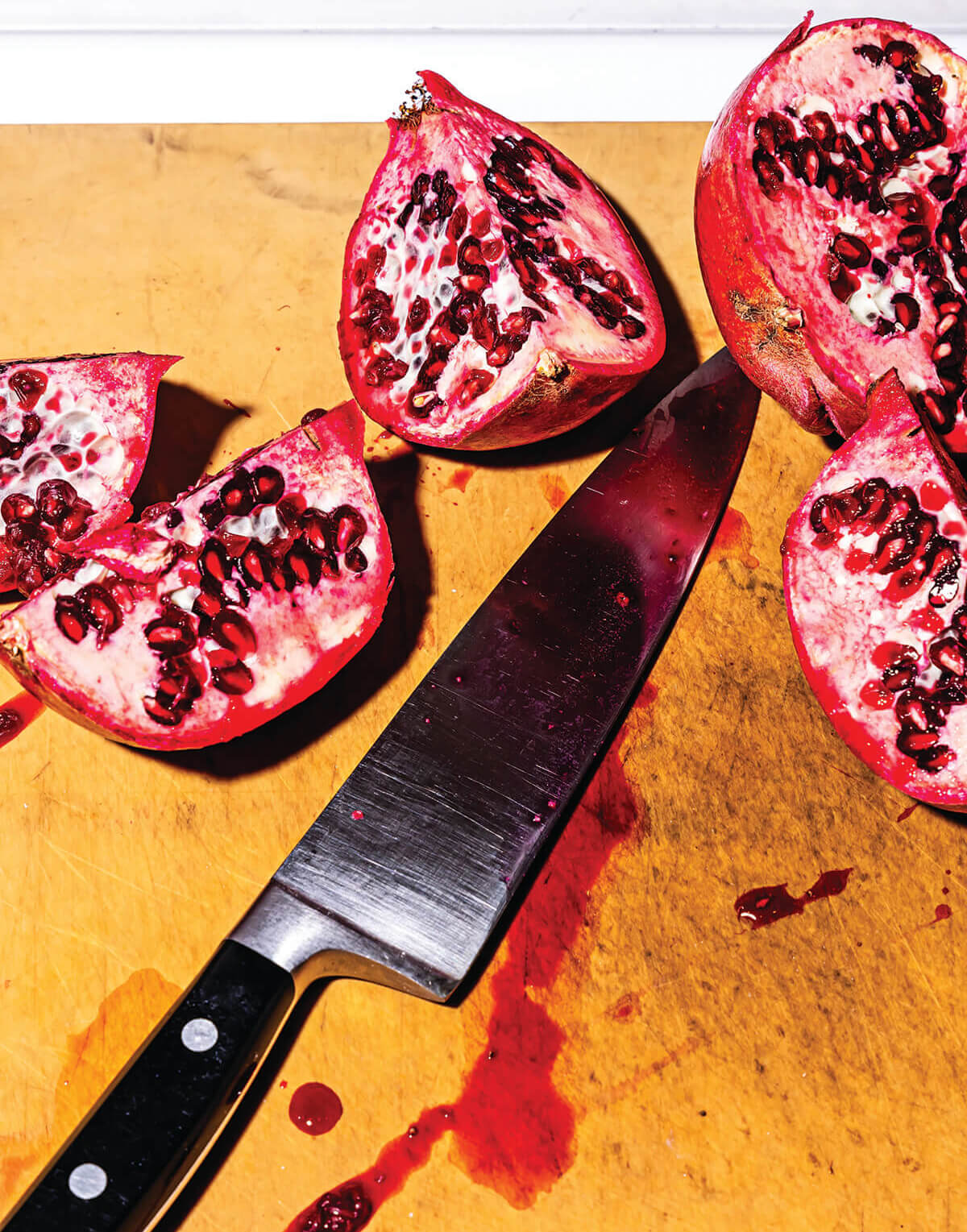
The smoked maitake mushrooms; chocolate caramel crunch; pomegranates get prepped; executive chef Natalie Carter.
Hours before dinner service begins at Liora, a florist from Flowers & Fancies tends to the hundreds of pothos and pachysandra plants sitting on shelving units at the restaurant’s sunny entrance. At Liora—Hebrew for “light”—the plants are more than décor; they’re a key to the menu mission. Vegan ambassador Mathew Kenney, who has restaurants from Bahrain to Buenos Aires, is proud to head up the Inner Harbor spot, the first upscale plant-based restaurant in Baltimore.
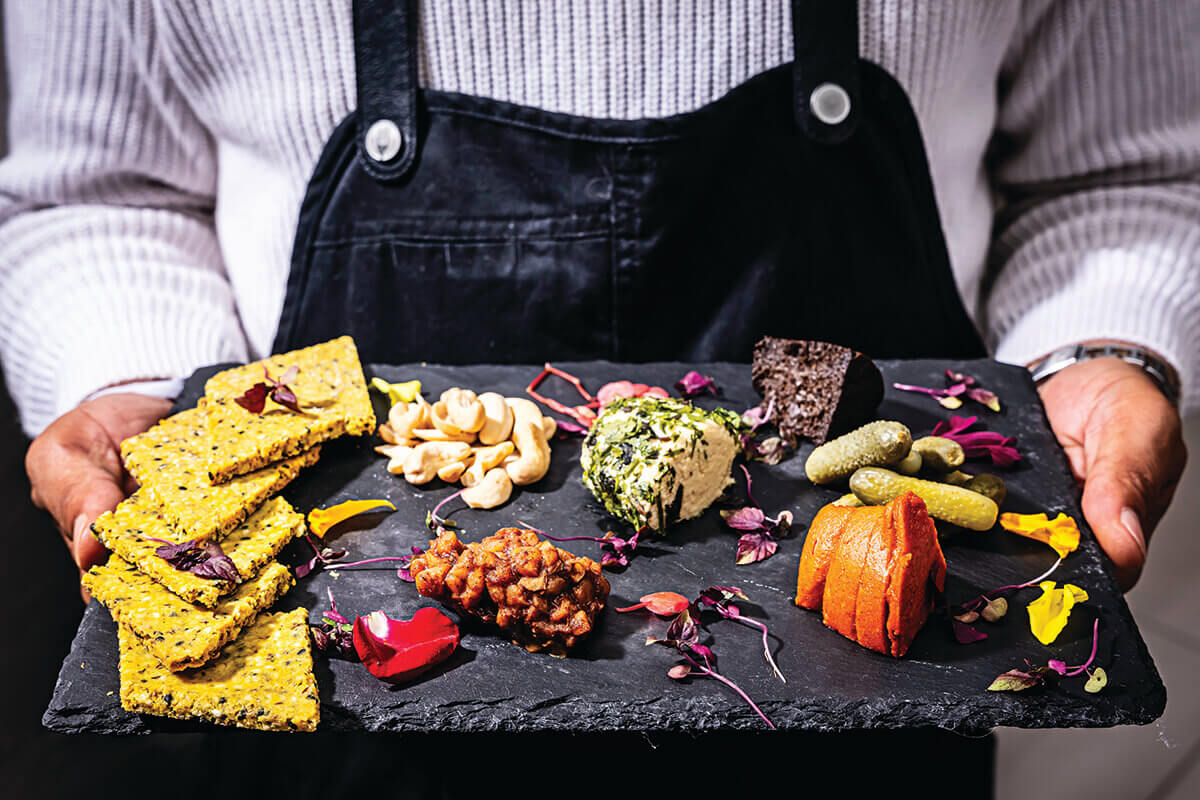
Liora's “cheese” plate.
On this fall day, executive chef Natalie Carter stands in the open kitchen making the restaurant’s signature entree of smoked maitake mushroom with cheesy grits. The dish, like others on the menu, is inspired by Southern cooking. “We are trying to pay tribute to the fact that we are the first state under the Mason-Dixon Line,” says Carter. “We love our collards, our grits, and our wild mushrooms.”
Before placing the lace-like funghi on a roasting sheet, she chops the rough edges. Next, she fans the caps out on a sheet pan, breaking them into chunks, dousing them with extra-virgin olive oil, and salting them generously. “We want to steam the mushrooms in all of their glory,” says Carter as she loads them into a 400-degree oven and then sets fire to a small tin of hickory chips that will smoke inside and add to the woodsy flavor. Later, as she plates the dish, she spoons a pool of cheesy grits—that’s sunflower seeds, lemon juice, and nutritional yeast as a stand-in for the dairy—and a handful of collards, braised with tamari-cider vinegar, caramelized onions, and Cajun-inspired seasoning flecked with small slivers of shiitake “bacon,” alongside the maitakes. After adding the final touch—a scattering of edible marigold petals—the dish is full of funk and flavor. And beautiful to boot.
At Liora, all vegetables, from beets that get barbecued to a jackfruit “crab” cake, are honored. “In vegan cooking, I’ve discovered all you need is spices,” says Carter. “That, and a little bit of oil, salt, and heat.” For the former chef of Great Sage in Clarksville, being a vegan cook translates to pushing herself to be innovative in the kitchen. That might mean adding nutritional yeast or blended cashews into a dish such as macaroni and cheese to impart umami and mimic the consistency of cheddar.
Ironically, as a young girl Carter was turned off by plant-based cuisine. “My mother married a vegan who also didn’t eat salt or sugar,” she says, “so my first exposure to vegan food is that it was godawful.” But after learning about the health benefits and environmental advantages of a vegan diet, she decided to attend Southern Adventist University in Collegedale, Tennessee, which has one of the few vegetarian culinary programs in the country. The experience was revelatory, and she hasn’t looked back since. These days, she says, “I’m a vegan chef because there’s really no reason not to be one.”
Azumi
HARBOR EAST 725 Aliceanna St.
Fish fanatics can’t do much better than a meal at this Harbor East sushi spot that boasts pristine products arriving daily from Tokyo’s Toyosu fish market. We’ll admit that we were sad when longtime executive chef Andy Gaynor left his post to pursue a knife-making business last December, but the kitchen, now helmed by Alisher Yallaev, is sharp as ever. Reserve a place in The Flame Room at one of the teppanyaki tables, sit at the sushi bar and watch how the pros roll, take a table in the stylish dining room, or rest outside and watch boats bobbing in the Patapsco as you contemplate whether to get the yellow jalapeño roll, tiger prawn tempura, robata lamb chops, or one of the splendid shareable platters glistening with an array of sushi and sashimi. The menu is rife with luxe ingredients like truffles, uni, and toro. If you’re going to go on a seafood bender, do it here.
Food for Thought:
Last year, Azumi sold one ton of Wagyu.
The Bygone
HARBOR EAST 400 International Dr.
As we soared upward to The Bygone’s 29th floor, a woman remarked that she could feel her ears pop. We didn’t notice an altitude change, but we experienced an attitude change as we stepped into the restaurant’s entryway, greeted by a stunning view of Baltimore’s skyline and a glamorous setting reminiscent of the Gatsby era, with burgundy velvet curtains, low lighting, and polished service. Offerings from the mostly American menu may seem tame (shrimp cocktail, slow-cooked short ribs), but the dishes won over our palates with their stellar ingredients and expert prep. The salmon ceviche and ethereal gnocchi supporting chunks of lamb-shank ragout set the stage for one of the best prime ribs we’ve ever had, and a seven-ounce local lump crab cake would make any Marylander proud. For a time, you really do feel like you are on top of the world.
Food for Thought:
The restaurant claims to have the largest whiskey list (around 700 bottles) in Maryland.
Charleston
HARBOR EAST 1000 Lancaster St.
For the past 25 years, the nine-time James Beard Award finalist chef Cindy Wolf has hit it out of the park at this jewel of a restaurant. Every dish she conjures feels like a sacred offering, be it bison tenderloin with black truffle and Burgundy reduction sauce or a foie gras tortellini en brodo. When Wolf’s not jetting off to her beloved Paris to eat at Michelin spots for inspiration, most mornings begin quietly, as she pages through her collection of cookbooks (Julia Child and Guy Savoy are a few of her muses). She then handwrites her seasonally inspired menu—a blend of foundational French cooking with Low Country influences—for dinner service, where she’s at the helm night after night. Wolf’s products are peerless, and she honors her ingredients by showing reverence to them with meticulously composed dishes, each its own work of art. Then there’s the positively regal service, a perfect playbook of how to tend to the table. This is how you do fine dining—all other restaurants are on notice.
Food for Thought:
Wolf once made a five-course lunch for her idol, Julia Child.
Cindy Lou’s Fish House
HARBOR POINT 1215 Wills St.
Cindy Lou’s is a haven for fans of elevated comfort food, and its relaxed décor (think cushiony banquettes and a flickering fireplace in the center of the dining room) fits right in with the theme. The Southern-focused menu—harkening back to co-owners Tony Foreman and Cindy Wolf’s first Baltimore restaurant, Savannah, in Fells Point—features soul-soothing standouts like a cornmeal-crusted chicken-fried steak and a fried chicken plate smothered in thyme gravy. If you’re looking for something lighter, there are mid-Atlantic nods, like the littleneck clam toast appetizer. Add the pan-seared rockfish in a mushroom Madeira sauce—plus a killer view of the Domino Sugars sign glowing over the waterfront—and you’ve got a mesmerizing meal.
Food for Thought:
Foreman and Wolf have ties to the South. Richmond-born Wolf got her start at Silks inside Planter’s Inn in Charleston, South Carolina, while Foreman’s great-grandmother was crowned Miss North Carolina in 1908.
Cinghiale
HARBOR EAST 822 Lancaster St.
Decisions are to be made from the moment you enter this Harbor East eatery with its emphasis on Northern Italian cooking. Do you want to sit on the casual enoteca side of the restaurant with its warm woods and bronze boar busts, or head to the osteria, with white table linens, leather banquettes, and a fine-dining feel? As for the offerings, do you want to start with a selection of imported cheeses from the salumeria, or should you move straight to selecting a wine from the cellar of more than 600 labels, including 50 vintages by the glass? (Yes and yes.) Of course, there’s a delicious array of food options, which includes a slew of house-made pastas (spicy squid-ink spaghetti with shrimp, squid, and lobster is a Poseidon’s paradise), oh-so-urbane antipasti (pan-seared foie gras, pasta e fagiole soup), and an embarrassment of riches on the entree end (from veal Milanese to saltimbocca). Even if you’re indecisive, the good news is, there’s no wrong answer. Rest assured, the most important decision you made was to eat here.
Food for Thought:
The mosaic flooring in the enoteca was excavated from an ancient stone quarry in Rome.


By Mike Unger
MT. VERNON 205 E. Biddle St.
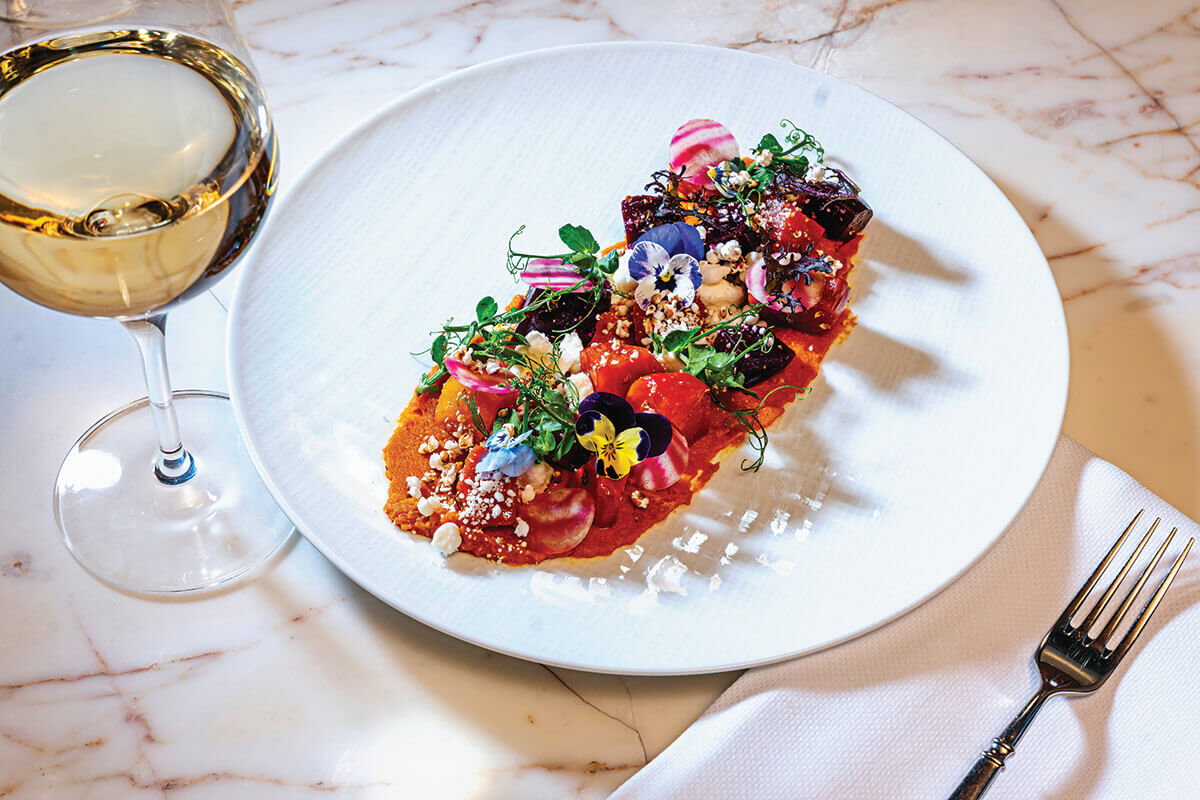
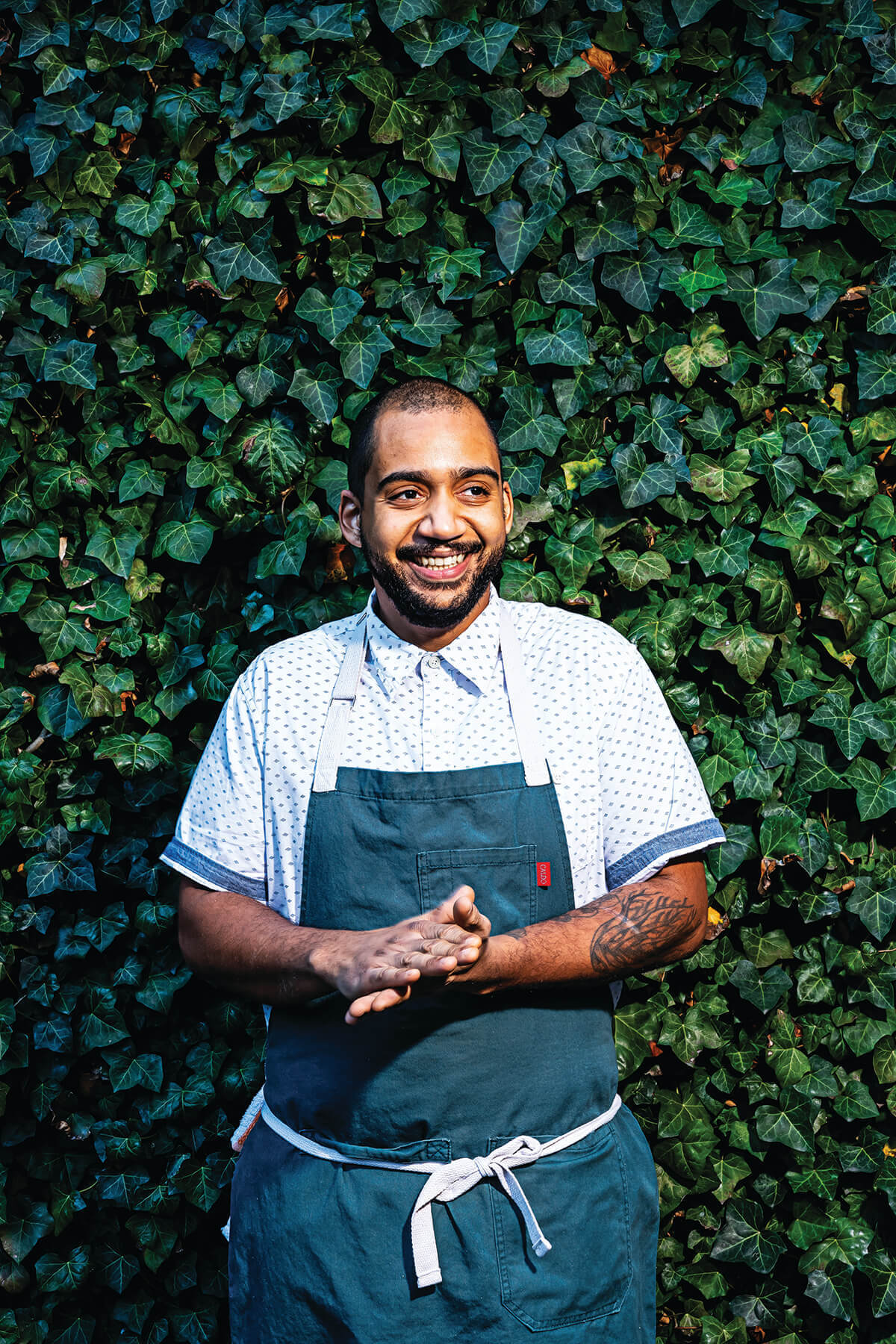
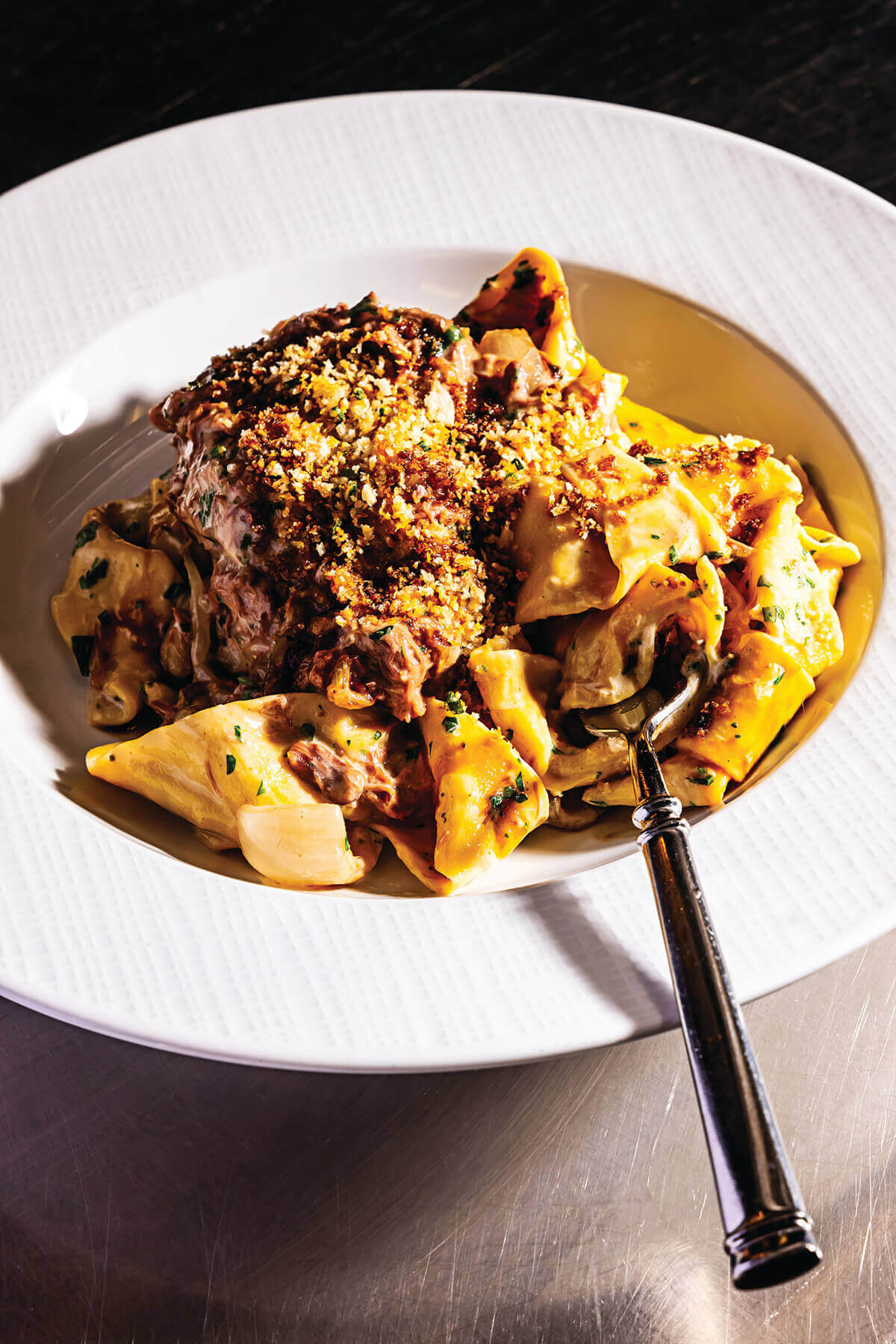
a seasonal beet salad; new head chef Scott Bacon; the tagliatelle with braised duck ragu.
By the time an order of tagliatelle with braised duck ragù reaches the kitchen of Magdalena, the “Maryland bistro” in Mt. Vernon’s swanky Ivy Hotel, most of the heavy lifting has been done. It started nearly 24 hours before, when chef Scott Bacon cured duck legs overnight in a blend of salt, spices, and herbs. The dish, like most of the recently revamped menu, is a creation of Bacon’s, the aptly named 31-year-old who took over as head chef in August. He was instrumental in the restaurant’s conceptual transformation from a fine-dining establishment to a still upscale but more approachable restaurant that “loosely” interprets Maryland classics. Steaks and pork chops are still available, but they’re joined by dishes like crispy-skin bass and roasted pumpkin and goat cheese ravioli. “This restaurant is very much in the style that I have been accustomed to cooking in, very locally sourced, very seasonal,” says Bacon, a Howard County native who previously worked at Cinghiale. “We have a dry-aged duck breast on the menu, and we get the ducks in whole, so we have a plethora of legs,” Bacon says as he prepares for a busy night in December. “Sustainability is something that I push towards. Using every single part of the animal that you get is something that I have always been very passionate about.” Thus the idea for the ragù. The morning after they cure overnight, Bacon braises the duck legs for about two hours, then shreds them before refrigerating the mixture. Around noon he makes the dough for the pasta, which he lets sit for about two hours. “The key to good pasta is having a good ratio of flour to eggs,” he says. “There’s a very defined finishing texture depending on what kind of pasta you’re making.”
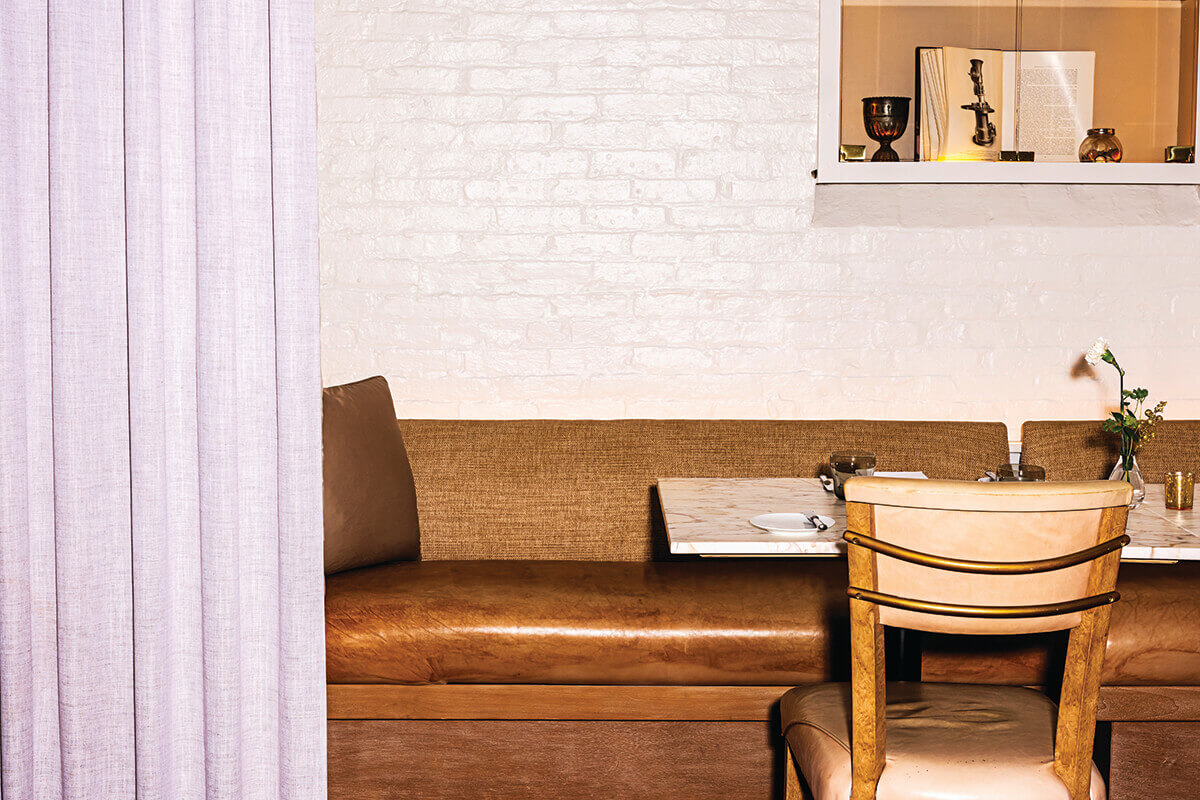
A cozy dining nook.
Today, he’s making tagliatelle, a thick noodle that pairs well with the ragù to create a hardy dish. He cuts it by hand, then balls it into four-ounce portions that are refrigerated until needed. When an order comes in, he drops a fistful into a pot of boiling water then gets to work on the meat of the dish. First, he pours garlic oil into a pan on the range. Next come pearl onions, which he sautees. He throws in thinly cut endives before adding four ounces of ragù. “Because the ragù is a byproduct of the dry-aged duck breast, it’s constantly been in flux,” he says. “At first, I was doing it with more sherry vinegar and sweeter flavors. The way it is right now is inspired by stroganoff.” After he adds braising liquid from the legs, he splashes in some of the water in which the pasta is boiling to add salt and starch. Finally, he adds a little sour cream, garlic confit, and Dijon mustard, ingredients that “thicken it a little bit and gives it a bite.” Bacon plates the dish by creating a “nest” of pasta in the bowl, to which he adds saba, an Italian unfermented grape juice. He’ll repeat this process up to a dozen times a night; along with the bass and the duck breast, it’s one of the most popular entree offerings on the menu. He pulls down his mask and tries a bite. “A dish like this, like any ragù, is supposed to be hardy, so the thickness of the pasta and the fact that it’s got a nice chew to it adds to all of that,” he says approvingly. “[With] a lot of the stuff that I cook, especially in the wintertime, I’m trying to take you home.” If home came equipped with a world-class chef, that is.
Clavel
REMINGTON 225 W. 23rd St.
Six years ago, this little taqueria took Remington by storm with its scrumptious tacos and marvelous mezcal program. We locals loved it from the start, but word soon went beyond our borders with routine recognition in industry bibles like Condé Nast Traveler, Bon Appétit, Esquire, and Saveur, which called co-owner Lane Harlan “The Most Interesting Woman in the Restaurant Business.” And then there’s that little thing called a James Beard Award nomination for Outstanding Bar Program, for which the mezcaleria has been nominated two times. Chef/co-owner Carlos Raba was also nominated this year in the Best Chef: Mid-Atlantic category. But all those accolades have not led Clavel to rest on its laurels. Since reopening for indoor dining in mid-2021, Harlan and Raba have devised an expanded menu of zippy cocktails and fantastic tortas and ceviches. Be forewarned: The minions flock just before opening hours—but standing in line at Clavel has become something of a Charm City rite of passage.
Food for Thought:
Clavel nixtamalizes its own corn tortillas, which makes them deeply flavorful and more nutritious than processed versions.
Cosima
WOODBERRY 3000 Falls Rd.
From the complimentary pillowy cheese rolls laced with cranberries at the beginning of a meal to the doughnuts dressed in cinnamon at the end, Cosima delivers homespun hospitality and earnest Southern Italian fare in a chic, renovated mill. Veteran chef Donna Crivello, billed as the concept director, devised a dining establishment that pays tribute to her grandmother’s name and cooking. Once you turn down the winding driveway off Falls Road, you feel like you’ve entered a Mediterranean plaza. Inside, diners can nosh on brick-oven pizzas, Mama’s meatballs, porcini pappardelle, and a standout meatloaf stuffed with a soppressata-and-mozzarellawrapped egg and painted with a spicy marinara sauce. There’s also a deck overlooking the Jones Falls, where patio heaters chase away the chill, herons fly by, and Nonna’s spirit lives on.
Food for Thought:
Before Crivello became a chef and restaurateur in the 1990s, she was an art director at The Baltimore Sun.
Duck Duck Goose
FELLS POINT 814 S. Broadway
When you start your meal with something as picture-perfect as the ratatouille at this tony brasserie, you know it’s going to be a good one. The thinly sliced rounds of squash, zucchini, and tomato—seasoned just so, painstakingly stacked, and topped with frisée—make up one of the many dishes that chef Ashish Alfred uses to show Baltimore what European cuisine is all about. Others include a Parisian gnocchi with chanterelles, herby lemon-garlic escargot, and the namesake honey-roasted duck breast over green lentils—which arrives topped with roasted grapes and bathed in a sweet sauce poured tableside. From the artful plating to the stylish décor, this is the kind of spot that truly transports you. But don’t get us wrong, it’s not stuffy. Whether you make a reservation for an intimate dinner or go for a round of drinks (the bourbon and citrus-forward Le Petit Mort cocktail is a winner), you’ll find that the ambience is as laid-back as Alfred himself.
Food for Thought:
Alfred—who has been sober for seven years—offers one of the most impressive zero-proof drink menus we’ve seen.
Dylan’s Oyster Cellar
HAMPDEN 3601 Chestnut Ave.
There’s so much more to this always-happening seafood bistro than just oysters (though this is a great place for the uninitiated). Start with the cocktails, which are inventive and made with care. Of course, the namesake shellfish, whether they’re consumed raw or roasted, are topnotch, but the kitchen shines in all its endeavors. Case in point: the juicy, crispy-edged smashburger, served on a quality bun that couldn’t hold a single additional sesame seed. Small plates like fried calamari and potato skins with a horseradish dipping sauce work as appetizers, sides, or a small entree. All hail the crispy coddies, made of cod and mashed potatoes, too. On a recent visit, we tried the lesser-known, local red drum served with sweet potatoes and kale. Like everything here, it all worked wonderfully together.
Food for Thought:
Co-owner Irene Salmon Donnelly hand-made the clay vases that adorn each table.
The Food Market
COLUMBIA 10480 Little Patuxent Pkwy.
The whimsy that defines Chad Gauss’s original Food Market in Hampden translates—albeit in a suburban kind of way—to the restaurant’s second location in Howard County. We’ll never quit the Hampden original, but we couldn’t resist giving this shiny new spot a little extra love this year. Once you enter the dining room, the atmosphere is as lively, the service as attentive, and the food as imaginative as it is at its big brother. Start with an order of mini lamb porterhouses, generously seasoned with an espresso rub. The shrimp dinner, served with andouille sausage atop cheddar grits with a Cajun thyme cream, conjures thoughts of a lusty jambalaya. Roasted beef short rib with whipped potatoes, carrots, Gouda, and a crispy onion ring is a perfect meal for a chilly night. We’ve never had duck as tender as the bird that came in the confit gumbo, which was presented with a tiny unopened bottle of Tabasco sauce on top. If that’s not whimsical, we don’t know what is.
Food for Thought:
Instead of bread, the restaurant serves popcorn with Parmesan and truffle seasoning before dinner.
Foraged
STATION NORTH 1709 N. Charles St.
Like many restaurateurs at the height of the pandemic, Chris Amendola feared for the future of Foraged. But fortunately, the chef, a certified mushroom forager, kept cooking, and his legions of fans kept coming. In fact, things have never been better. Last December, Foraged moved from its former slip of a space in Hampden to “restaurant row” in Station North. There’s now a full bar with clever cocktails, almost twice as many seats, and the ultimate imprimatur, former Sun food critic Richard Gorelick as the restaurant’s host. Thankfully, what hasn’t changed is the vigilantly seasonal menu. Here, every plate feels like a gift of the season—a simple tomato dish with goat cheese, watermelon, basil, and wineberry vinaigrette is summer on a plate, while the duck breast with squash pur e and fennel expresses every element of fall. The chef’s love affair with mushrooms remains intact, so look for plenty of wildly creative funghi-forward dishes, too.
Food for Thought:
From collards to marigolds, Amendola is growing an “edible forest” behind his Freeland home to provide native and heirloom crops for Foraged.


By Jane Marion
SPARKS-GLENCOE 14833 York Rd.
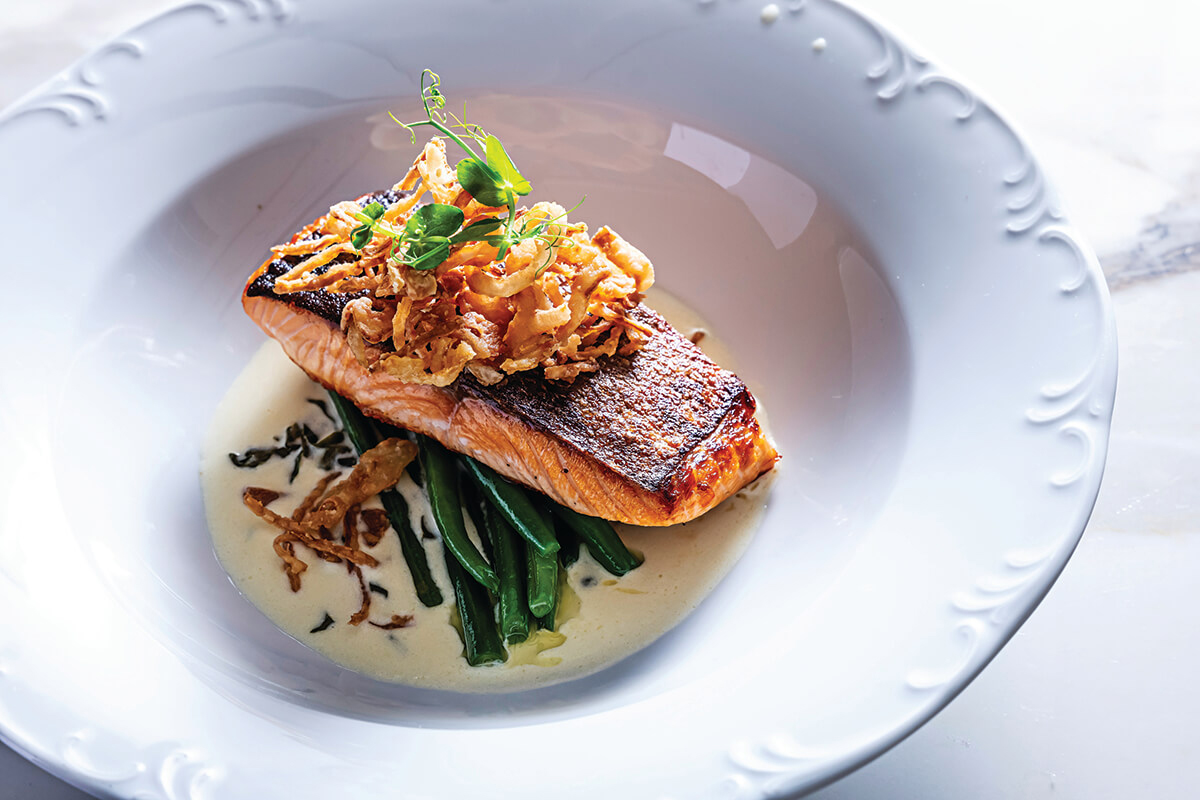
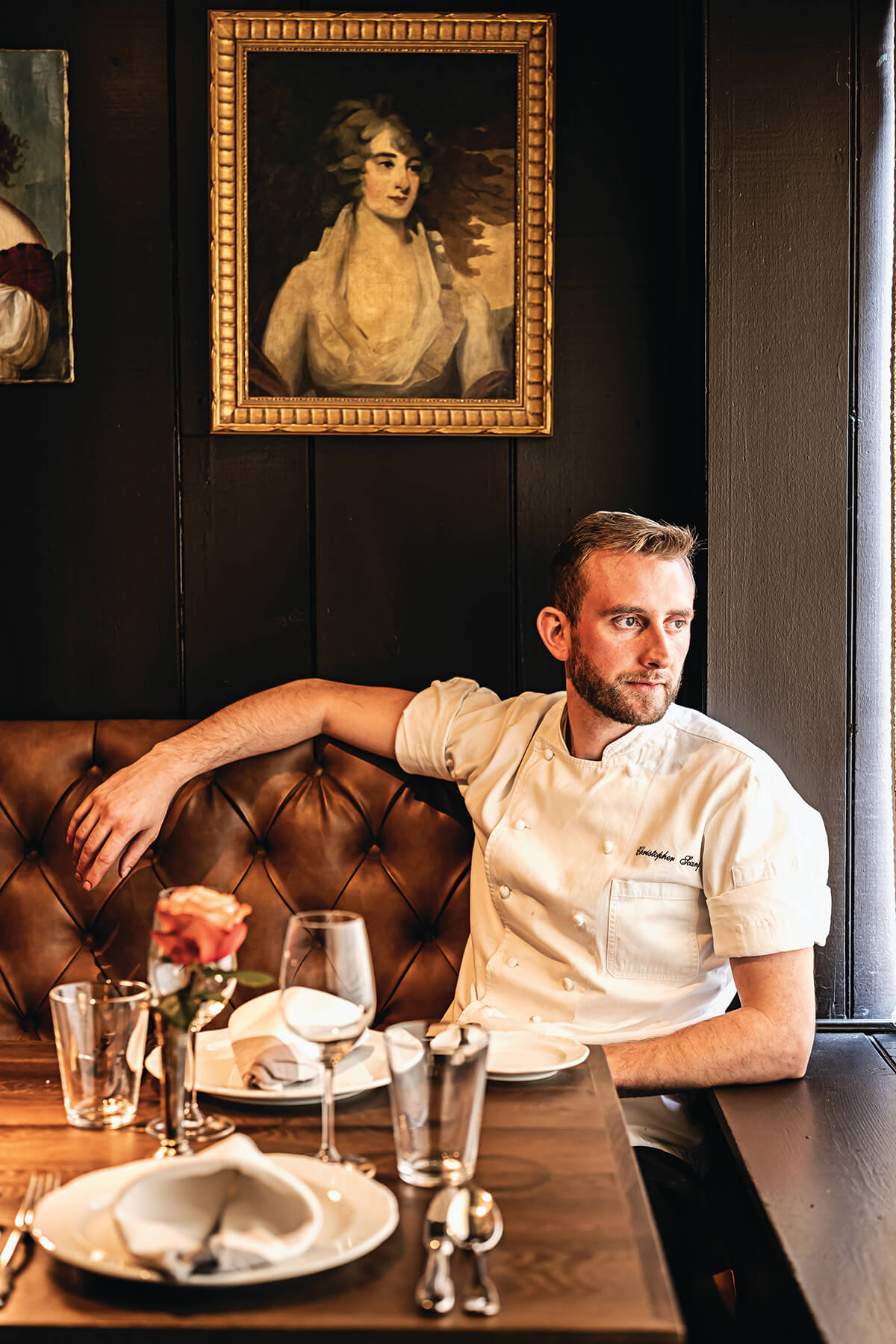
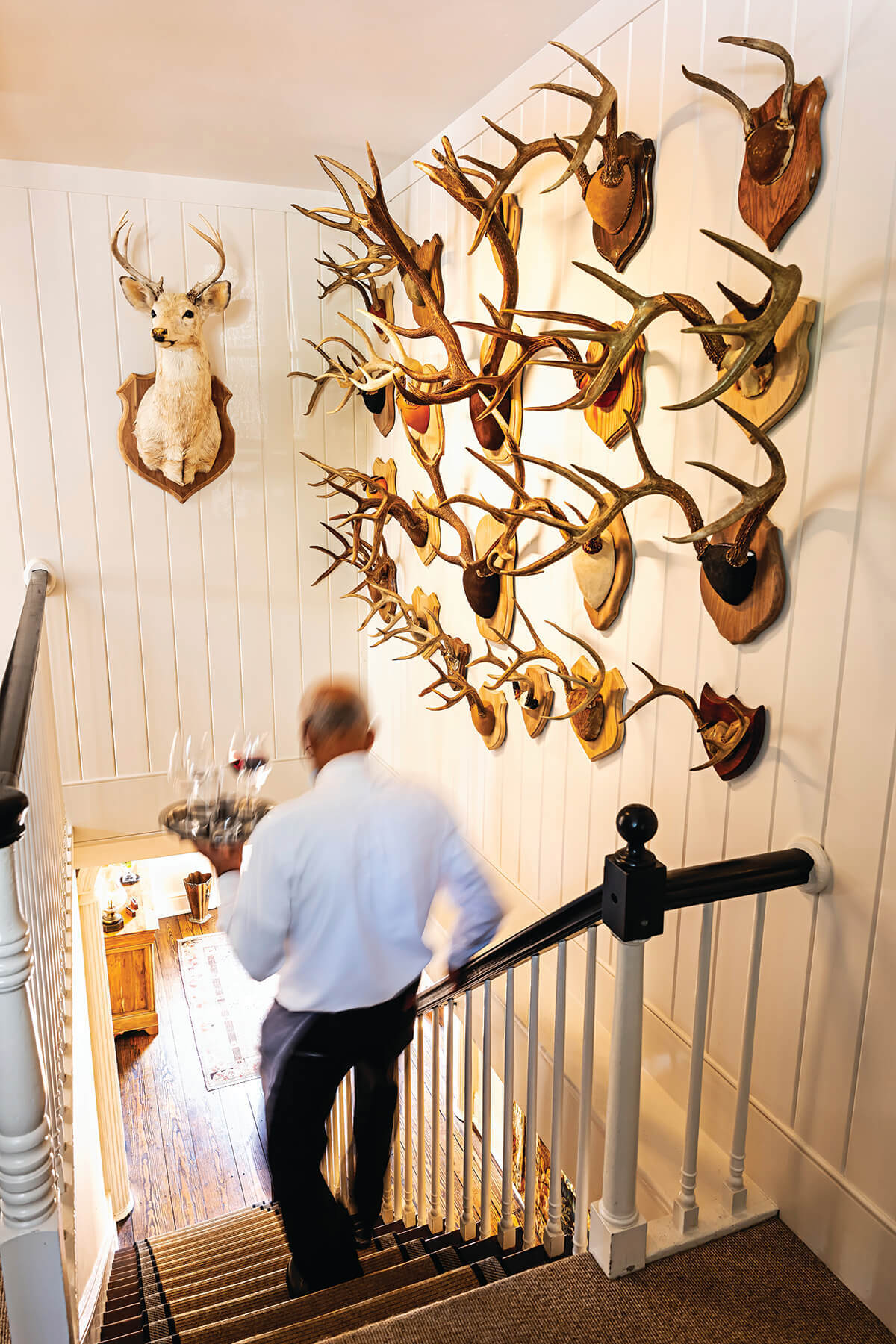
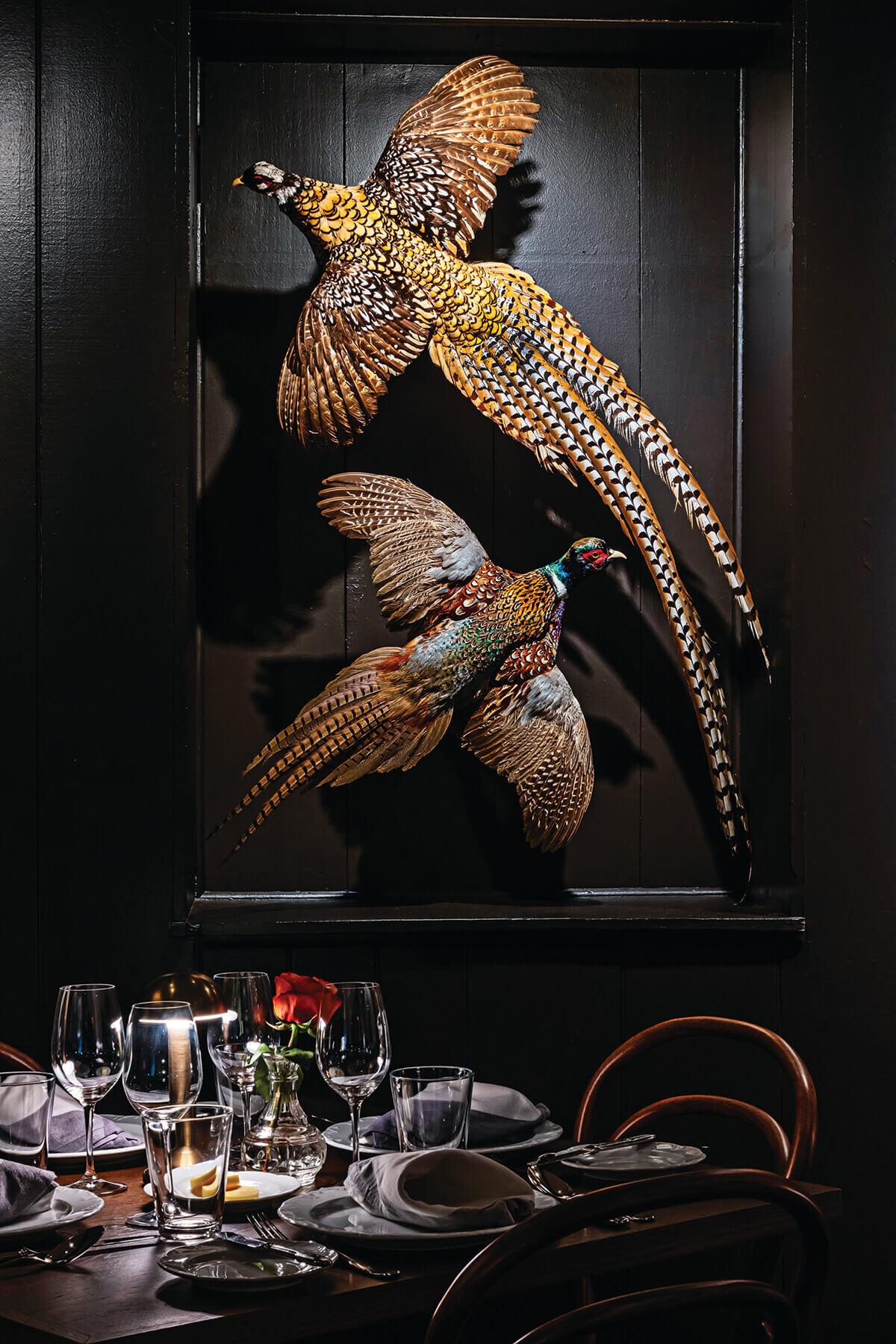
The salmon in sorrel sauce; Chef Chris Scanga before service; hunting lodge décor; the Hearth Room.
At one o’clock on a fall afternoon at The Milton Inn, several diners sit on the alfresco patio while a couple enjoys a bottle of wine and the prix-fixe lunch of braised beef short rib with honeynut squash purée in red-wine reduction sauce. In the back of the house, the restaurant’s chef-partner Chris Scanga moves around the kitchen, overseeing the curing of the salmon, entering the walk-in refrigerator to survey the daily ingredients sourced from local farms (edible flowers and Jerusalem artichokes from Karma, beets and acorn squash from Ridgefield), checking on deliveries, and getting ready to break down the squab, which will later get pan-roasted and served with potato dauphinoise as one of about a dozen principal plates on this French-focused, game-forward menu.
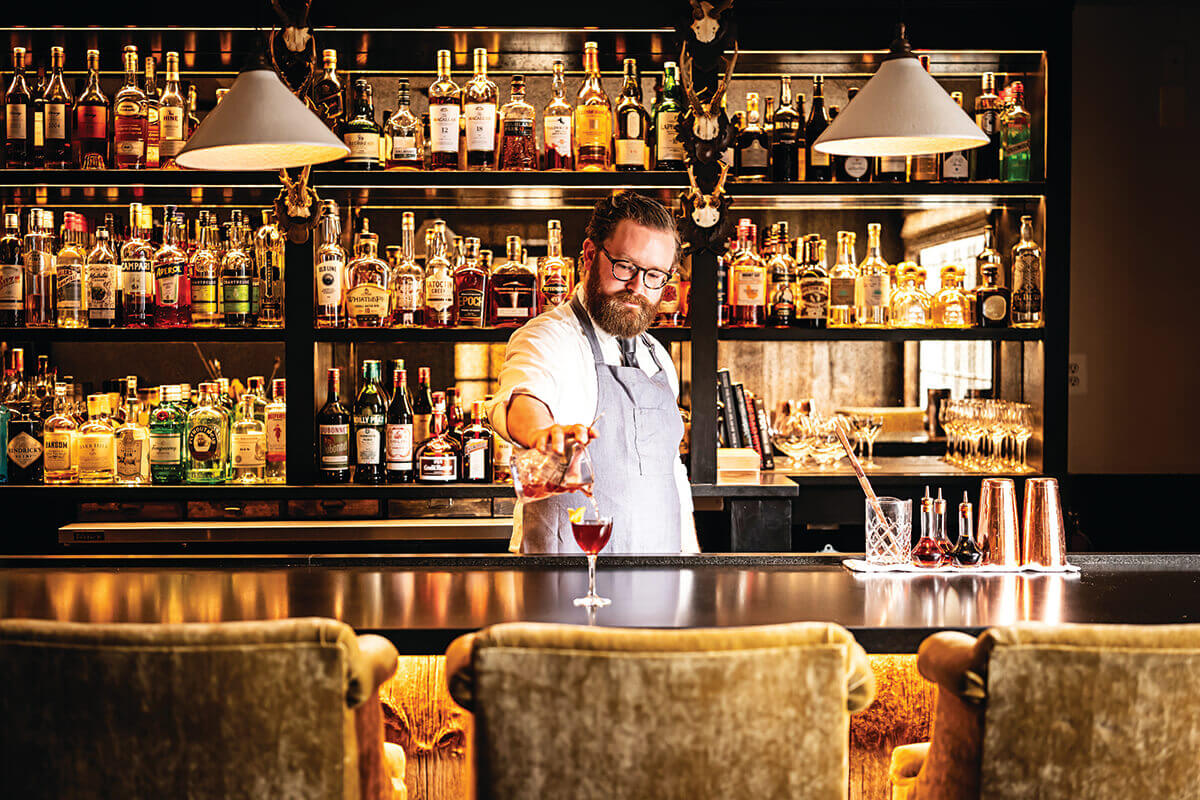
Bartender Andrew Dissen
Even on this first-ever day of lunch service since the restaurant’s opening in July, it’s a rare quiet moment for a chef who has been going full tilt for many months now. Within days of the summer opening, reservations were booked for weeks. A lot is riding on this moment for the former Petit Louis Bistro chef, who, along with restaurateurs Tony Foreman and Cindy Wolf of the Foreman Wolf Restaurant Group, became a partner of the place—salvaging a county institution when the original 70-year-old restaurant of the same name became an early casualty of the pandemic.
“I knew we’d get crushed,” says Scanga, whose job keeps him on his feet about 16 hours a day. “I knew once we opened, I’d be eating hot dogs and protein shakes and not exercising, so starting in January, I ate a very specific diet and exercised and lifted weights to get myself in proper form. I knew what was coming. But if I’m going to get a chance to be in the race, I might as well run. I trained for this like I would train for an Olympic event.”
Though he’s now 30 pounds lighter since the inn opened three months ago, he says it was worth it—and it’s hard to argue. Hours later, during dinner service, as museum-worthy plates come off the line—a pâté en croûte punctuated by flash-fried sage sitting on a smear of raspberry purée, an Instagram-worthy plate of steak tartare with Ossetra caviar—it’s clear that the chef is going for the gold.
At the beginning of dinner service—which will eventually top out at 180 guests—Scanga sips a cup of coffee while reviewing the tickets. “Swordfish, medium-well, pick-up magret,” he calls out in a mixture of English and what he calls “kitchen French and Spanish.” “One saumon in sorrel sauce.”
The salmon in sorrel sauce, one of the most popular items on the otherwise game-heavy menu, was inspired by the classic dish at Troisgros in the heart of the Loire Valley, one of the regions of Southern France that defines the menu. The 32-year-old chef learned to cook the dish by watching a YouTube video of a chef making it from the storied restaurant. “This is our interpretation of the dish, but I haven’t strayed too far,” he says. “The mission here is to bring French cooking to people who have had it and are like, ‘this is the real deal,’ or they haven’t had it and are like, ‘this is approachable, and it makes sense, it’s easy to get behind.’” For this particular dish, Scanga has added his own spin by pairing it with haricots verts and lightly fried rings of onion. He sends some 40 orders out into the dining room a night—and tonight is no exception.
With a quick break in the action around six o’clock, he takes a moment to reflect. “Essentially, we have three people feeding 200 people in two hours,” he says. “You’d think it seems like less of a miracle the more you understand, but the more you understand, the more of a miracle it is.”
Gertrude’s Chesapeake Kitchen
CHARLES VILLAGE 10 Art Museum Dr.
Open since 1998, Gertrude’s is one of those reliable restaurants that may get overlooked as new upstarts vie for our attention. But every time we go, we think, “Why don’t we come here more often?” Attached to the Baltimore Museum of Art, the dining room is soothing, with a taupe-and-red palette and cloth-covered tables. In these tense times, an outside stone terrace, partially tented, offers solace, too, overlooking a bubbling fountain and the museum’s impressive sculpture garden. The scene is boosted by chef-owner John Shields’ commitment to serving seasonal, local ingredients with a focus on the Chesapeake Bay. We never tire of Gertie’s crab cake—named after Shields’ grandmother, Gertrude Cleary, also the restaurant’s namesake—or the fried oysters, or the crispy Maryland pan-fried chicken, blessed with mashed potatoes and gravy. The state’s culinary heritage is on full display here
Food for Thought:
Baltimore native Shields didn’t always hawk the bounty of the bay. One of his first cooking gigs was at a French restaurant in Berkeley, California.
Gunther & Co.
BREWERS HILL 3650 Toone St.
There’s always something fascinating on the menu at this restaurant, housed inside the century-old boiler room of the Gunther Brewing Company. It closed for three extended stretches during the pandemic, but when we visited on the Tuesday after Thanksgiving, the multiple bars and dining rooms (including a wow-worthy patio with fire and water features) were bustling. We started with Maine halibut crudo with passion fruit, coconut milk, and habanero, topped with avocado and crispy rice. Next came the grilled bone-in pork chop, a tremendous piece of meat whose flavor was accentuated by the accompanying crispy smashed sweet potatoes, sherry-maple-glazed fried Brussels sprouts, bacon lardons, fennel, and apple-Dijon purée. Aesthetics matter here. The cocktails and dishes are attractively assembled, and the restaurant’s interior design is warehouse chic.
Food for Thought:
Each bill comes with a three percent “Labor of Love” service charge that’s used to provide health insurance, lost earnings, etc. to the restaurant’s staff. You can opt out by asking your server, but we support the sentiment.
The Helmand
MT. VERNON 806 N. Charles St.
Is this 32-year-old Afghan treasure the sexiest spot in the city? No. In restaurant years, 30 is an eternity. But here’s the thing: It’s still one of the best. When you walk into the charmingly unstuffy dining room, you’re treated like a treasured guest. The menu rarely changes, which is a good thing. There’s simply no improving on classic appetizers like banjan laghatek, aka stewed eggplant with garlic, tomatoes, and peppers served with yogurt and cilantro sauces, or mantwo pastry shells filled with onions and beef topped with yellow split pea sauce. The koufta challow beef meatballs—seasoned with sun-dried baby grapes, paprika, and turmeric, served in a green pepper, green pea, and tomato sauce—is beautifully complex. No matter what makes its way from your plate to your stomach, each bite leaves you excited to find out what the next bite will bring.
Food for Thought:
The Helmand sources the pumpkins for its beloved kaddo borwani appetizer from a family farm in Howard County.
Iron Bridge Wine Company
COLUMBIA 10435 State Route 108
Celebrating two decades next year, this cozy haunt along Route 108 in Columbia is remarkable as ever—and the wine still takes center stage. To wit: You’ll see endless rows of vino, bottled everywhere from Sonoma to Spain, on display in the snug dining rooms. And with a rotating menu of seasonal dishes, as well as recurring specials, you can feel the pride this place takes in being both a destination for visitors and a go-to for locals. It doesn’t hurt that chef Corey Laub—formerly of Fork & Wrench—is a HoCo native. Since September, Laub has whipped up inventive fare such as mushroom-stuffed porchetta and a seafood stew loaded with scallops, mussels, shrimp, clams, and soft squid ink spaetzle. On a recent outing, we savored every bit of the spicy tomato broth, along with a satisfying lamb flatbread and butternut squash-stuffed arancini. Even the house burger with pimento cheese has that extra something special.
Food for Thought:
Every Tuesday is crème brûlée night. If you’re served the prized ramekin without chocolate ganache, you win a free bottle of wine or dinner.
JBGB’s
REMINGTON 2600 N. Howard St.
There’s a butcher shop and upscale restaurant in the industrial brick building on North Howard Street in Remington that’s worth your while. No, we’re not talking about Parts & Labor, which appeared on this very list before closing in 2018. Into that void stepped JBGB’s, a sister spot to the popular John Brown General and Butchery in Cockeysville. Not that the former is a carbon copy of the latter. Pizza is the star at this fantastic new restaurant. In addition to the wonderfully cheesy pies that emerge from the wood-fired oven, executive chef Tyler Johnson offers approachable entrees ranging from a cheeseburger to chicken to Bolognese. Appetizers like steak tartare and the pâté plate use meat from the butcher side of the house. All are terrific, but not even they outshine bar manager Shaun Stewart’s inventive cocktail list that includes the Dijon-Vu, a mustard-based drink that’s shockingly refreshing and unlike anything we’ve ever tried.
Food for Thought:
Buy something at the butcher shop and the butcher will hold your purchases in a fridge until after your meal.


By Mike Unger
CANTON 2322 Boston St.
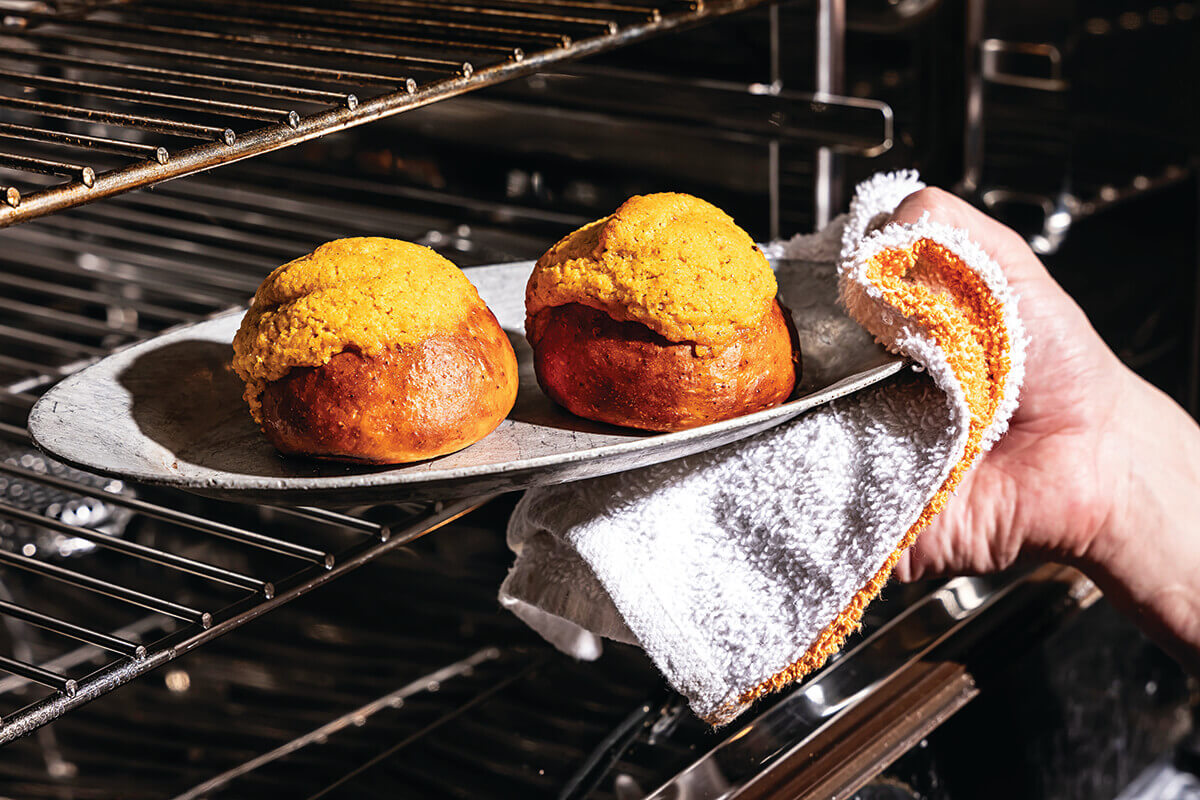
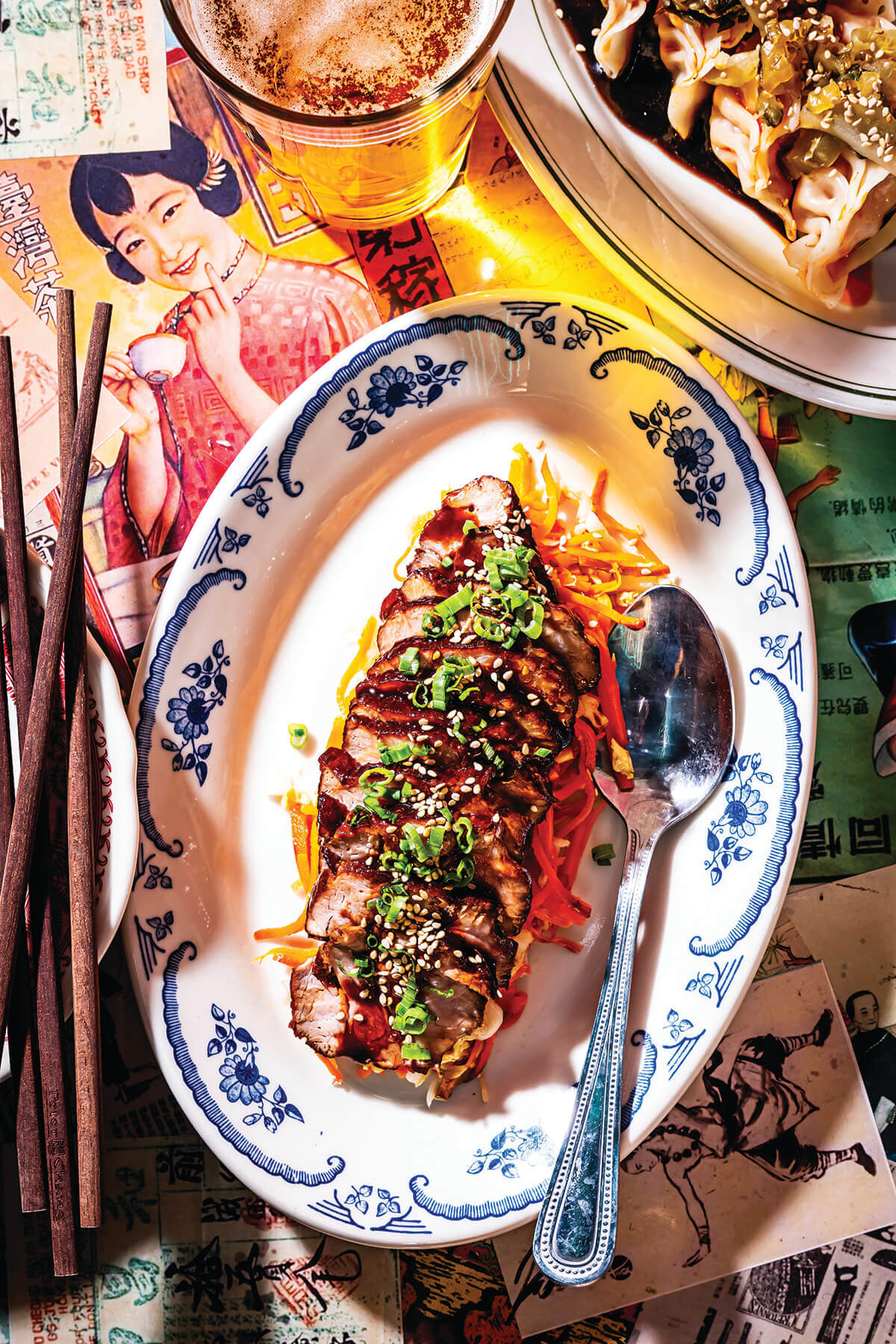
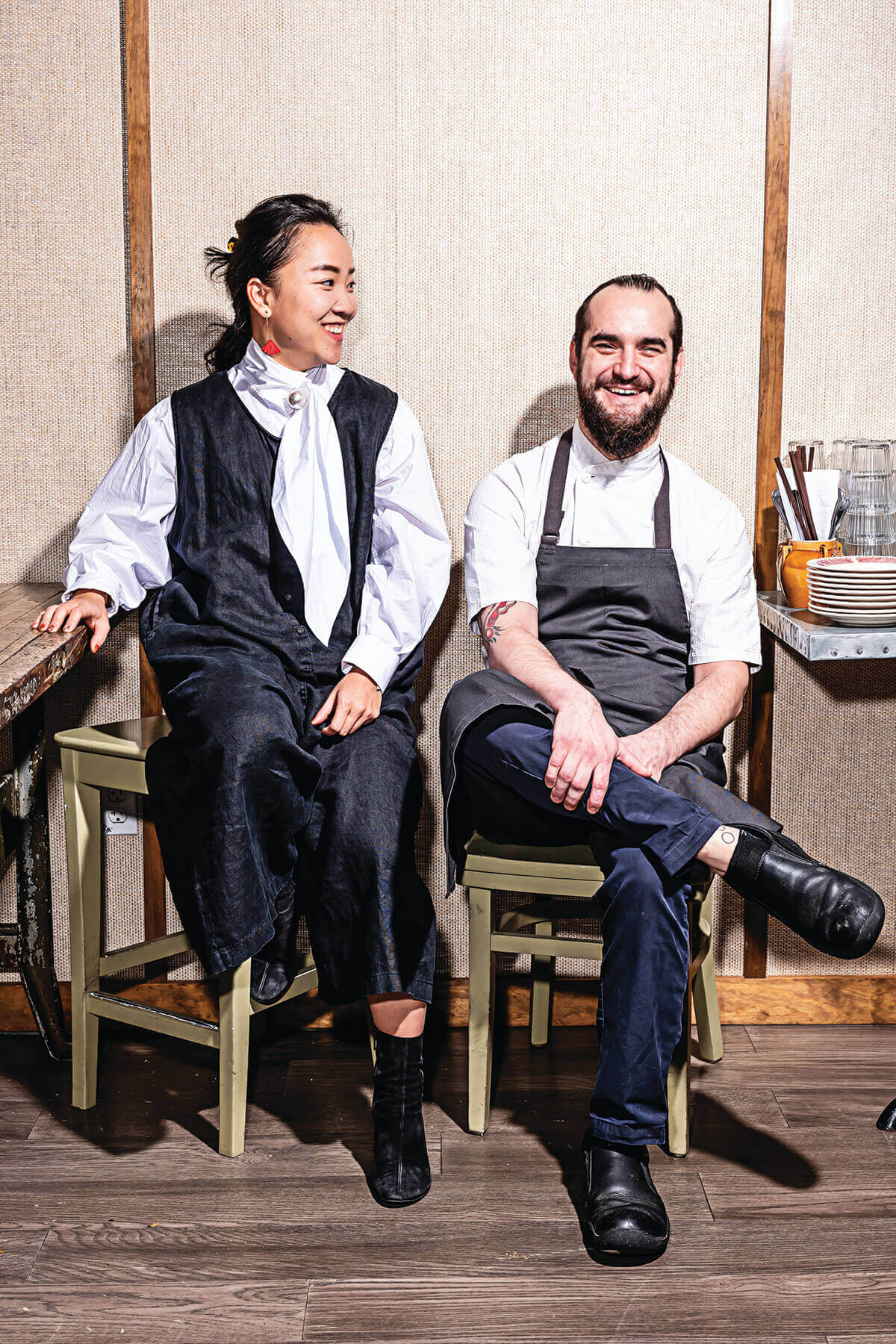
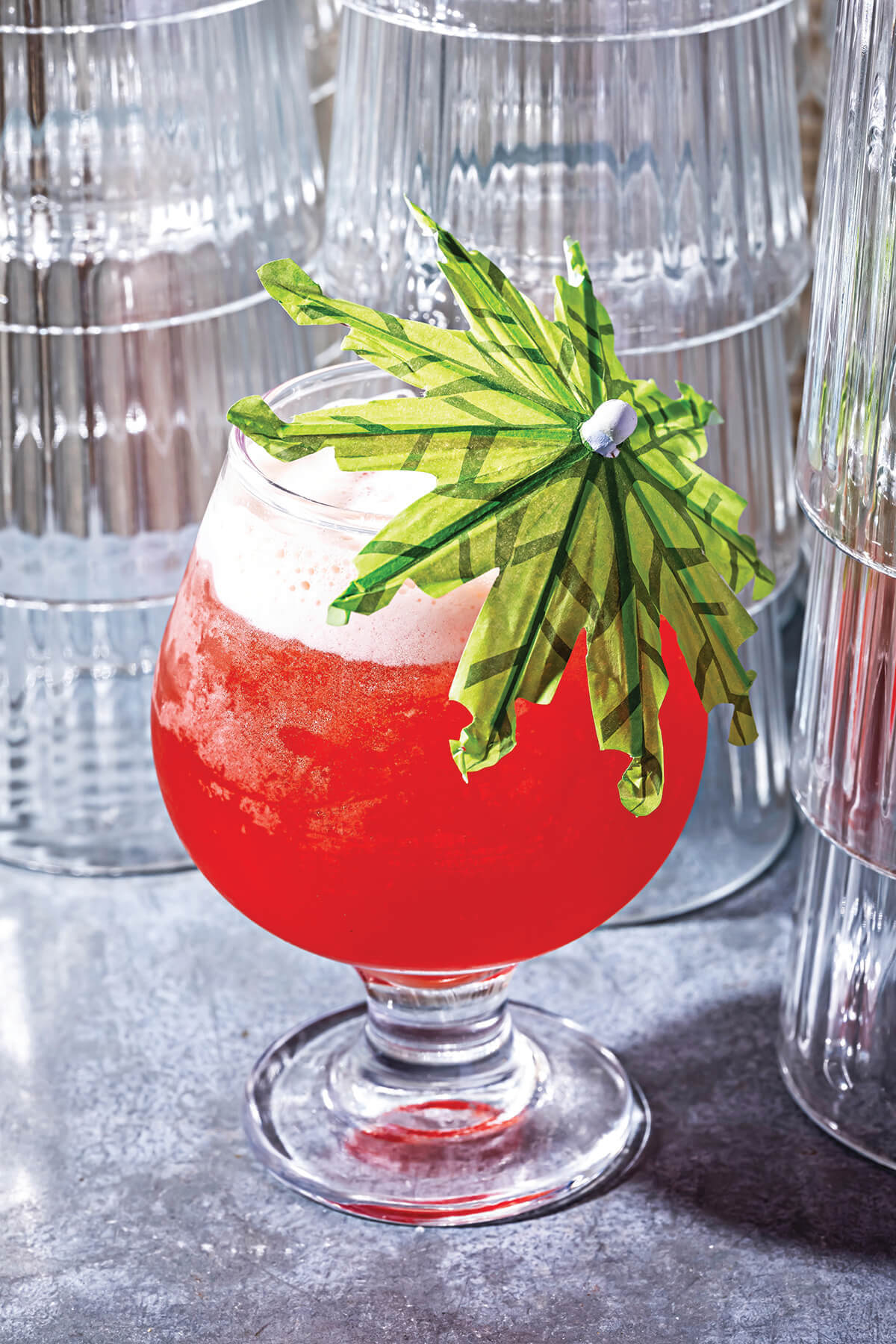
Lamb buns; red braised pork; owner Lydia Chang and head chef Antoni Szachowicz; the Red-Crowned Crane mocktail.
Chef Antoni Szachowicz inspects the lamb bun with the focus of a jeweler examining a diamond. Minutes earlier, he’d applied a curry crust around the rim of the bun and put it back in the oven for an additional four minutes. Now he’s checking to ensure that it’s perfect before sending it out into the dining room at NiHao, Lydia Chang’s wildly popular and innovative Chinese restaurant that was just named a semi-finalist for Best New Restaurant by the James Beard Foundation. “What we’re trying to achieve is to get the bun brownish without over-cooking the curry crust on top,” he says. “If you put the curry on too early, you’ll have a brown crumbly crust versus something that’s a little bit lighter and brighter looking.” It’s a Tuesday evening in November, and this final eyeballing is the culmination of a process that began hours ago. The filling for the buns, which were created in part by Szachowicz, who’s worked at the restaurant since it opened in July 2020, starts as ground lamb. Szachowicz roasts 20 pounds of it for 15 to 20 minutes to render some of the fat. In goes garlic, ginger, and red onion, then Szechuan chili powder and peppercorn and toasted cumin. “It’s almost like a standard braise,” he says. “You sear your meat, take out the meat, you sear your vegetables or your aromatics, deglaze the pot, add the meat back in.”
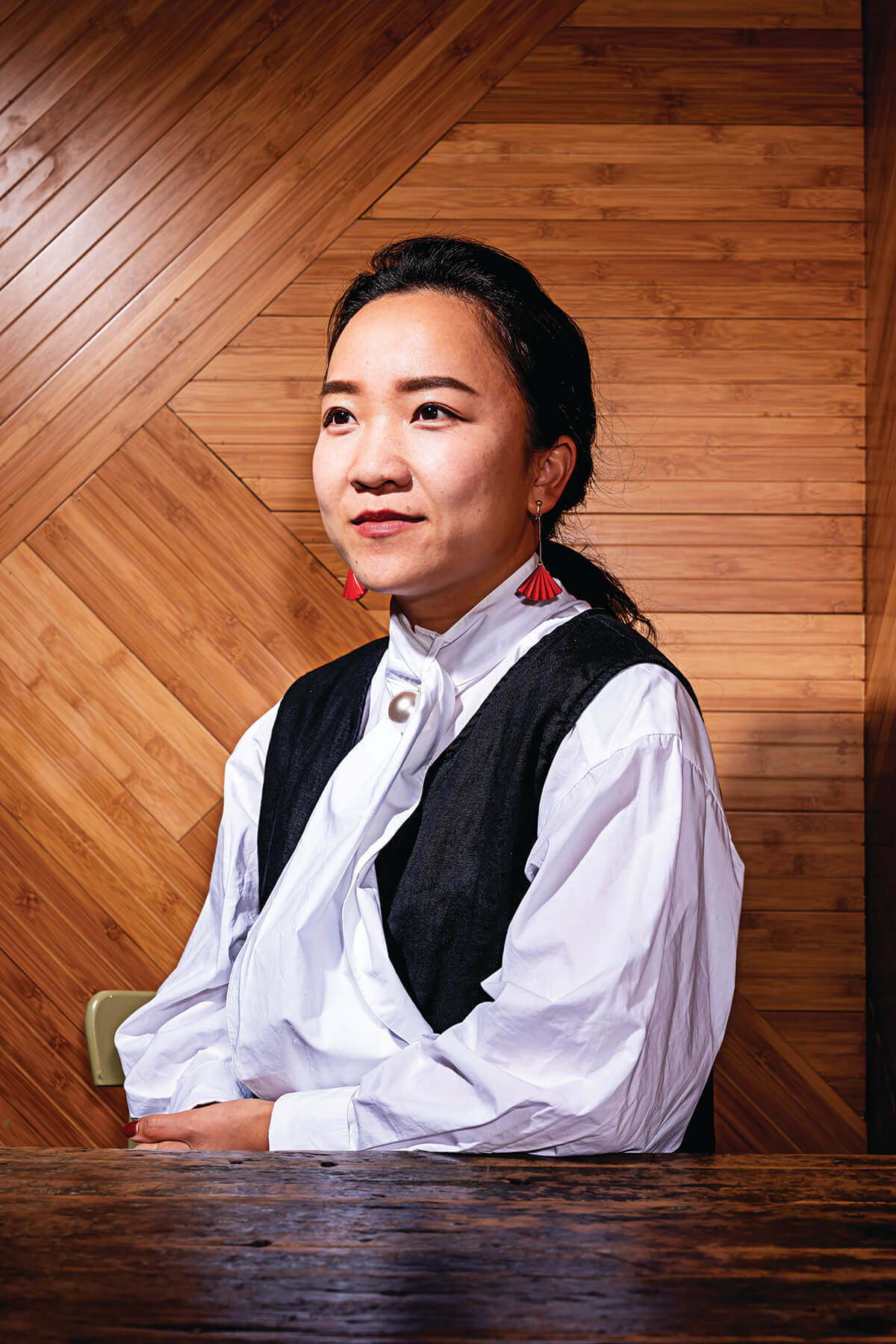
Chang presides.
After Szachowicz pours in vegetable stock and soy sauce, the mixture cooks for about 90 minutes on the stove before being placed into a large mixing bowl with ice underneath for a half hour of cooling. It’s then placed into raw dough made from buttermilk, butter, flour, eggs, and yeast. Once the buns are formed, they’re steamed for 12 minutes before being refrigerated. When an order comes in, the buns are re-steamed, then baked at 400 degrees for three minutes before the curry crust—a combination of butter, Crisco, flour, sugar, and an Indian brand of massaman curry paste—is added. Szachowicz is meticulous in ensuring each one comes out just right. As he pokes and prods the buns, cooks prep for the dinner rush in the small second-story kitchen. One stirs a boiling pot of stock made from duck bones while another slices mustard greens for the shrimp dumplings and a third chars cabbage for an eggplant dish.
The sophistication of NiHao’s fare helped it earn accolades from the likes of Esquire and The Washington Post. Lydia Chang’s father, Peter, is a renowned chef with several restaurants in the D.C. area, but here his role is primarily an advisory one. Lydia runs most facets of the restaurant, but she is not a chef. She leaves the cooking to Szachowicz, whose idea it was to replace the buns’ crabmeat with lamb when the cost of former skyrocketed. “It’s a very classic flavor combination,” Szachowicz says of the buns, which pack a multitude of flavors. “The pungency of the cumin helps counteract some of the gaminess of the lamb. Cumin and curry go well together, as well. The filling itself is rich. The sweetness from the curry crust balances it out so you get sweetness and savory.”
La Barrita
BUTCHER’S HILL 32 N. Chester St.
Even on a raucous Friday night in January when nary a table or barstool is unoccupied, the staff at this three-year-old rowhouse restaurant specializing in Argentine fare doesn’t appear to be stressed. In fact, they seem to be having a blast—there’s no doubt that the diners are, and for good reason. Each course that arrives is better than the last. The meal starts with warm bread (like everything else here, made in-house) with chimichurri. This is a recurring theme: Almost everything tastes even better when topped with that delectable traditional Argentine sauce. Empanadas arrive next. All the varieties are tasty, but we’re partial to the Angus beef. Our main course, Costilla Entera, is a bone-in short rib that is cooked to perfection. As we try to finish it, the crowd starts to thin out and the volume begins to subside. But we linger, finishing our Malbec and enjoying conversation with our party—and our bartender.
Food for Thought:
In Spanish, La Barrita means “the little bar.”
La Cuchara
HAMPDEN-WOODBERRY 3600 Clipper Mill Rd.
When the Basque Country-themed La Cuchara opened some seven years ago, not many Baltimoreans knew what the name meant (“the spoon” in Spanish) or what an asador or pintxos were (a wood-fired grill for preparing protein and small snacks, respectively), let alone how to pronounce them. But great restaurants expand our horizons, pushing our palates to electrify all 10,000 of our tastebuds. La Cuchara does just that. The restaurant is a family affair, with Jake Lefenfeld working the bar and front-of-house, while his big brother, chef Ben Lefenfeld, transports us to the Pyrenees with every slice of Ibérico ham and shot of sherry. Ben’s wife, Amy, works mostly behind the scenes. The ingredients are impeccably sourced (sprat tin fish from the Baltic Sea!), and the food manages to be both refined and rugged. The Lefenfelds always delight us with new surprises on every outing, while old standards like the pan con tomate continue to sate. The paella with sofrito rice is the best example of the dish we’ve ever eaten. Don’t miss the tented patio—it’s charming in every season.
Food for Thought:
The Basque Country boasts the most Michelin-starred spots per capita in the world.
La Scala Ristorante Italiano
LITTLE ITALY 1012 Eastern Ave.
While many other Little Italy restaurants have folded, La Scala has survived and thrived for more than 25 years with its authentic Old World Italian dishes. You can count on long-simmered sauces, housemade pasta, impeccable meats and seafood, and traditional desserts. And as he’s done for years, chef-owner Nino Germano cruises through the dining room nightly, checking on new and familiar diners. At one table, there might be two elderly neighborhood guys dishing about the old days over a bottle of Chianti. At another, a quartet of millennials downing fancy cocktails and down-home spaghetti. As Pavarotti belts out tunes over the sound system, it’s easy to be wooed by the charming brick walls and wrought-iron d cor, while savoring crisp calamari, Bolognese with spinach fettuccine, and shrimp scampi in a buttery, garlicky sauce. We’re smitten. A chocolate-hazelnut cannoli at the end of the night seals the deal.
Food for Thought:
An indoor bocce court was added to the restaurant in 2008.
Le Comptoir du Vin
STATION NORTH 1729 Maryland Ave.
During the pandemic, Rosemary Liss and Will Mester transformed their nationally renowned European-style bistro into a specialty shop that, at various points, sold bottles of natural wine, curated pantry items, and takeout sandwiches. When we heard they were re-starting weekend dinner service in late November, we were so excited that we were there on opening night. It was as if almost nothing had changed. Cocktails and nine dishes were written on chalkboard menus, and everything we tried was as expertly prepared as we remembered. We started with a bowl of marinated olives before moving on to a beautifully simplistic poached chicken with carrots and turnips in a rosemary-anchovy broth. The beef cheek and fontina toastie was essentially a delectable grilled cheese for grown-ups. We finished with a plate of Coolea, an Irish cheese in the style of a Dutch Gouda. It was a lovely way to cap off a triumphant return.
Food for Thought:
The restaurant recently debuted a new dining space downstairs that’s understated but warm and inviting.


RIVERSIDE 1843-45 Light St.
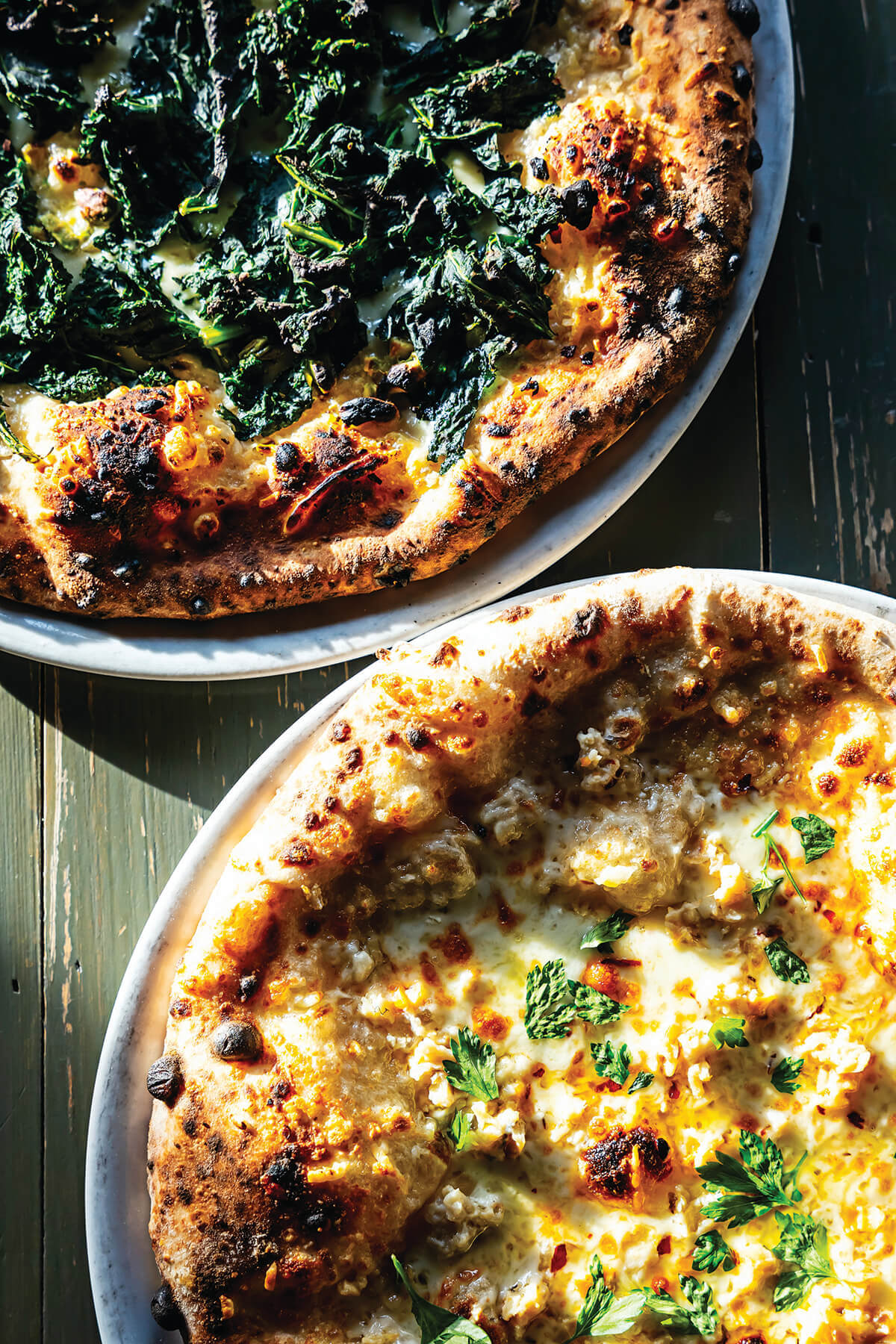
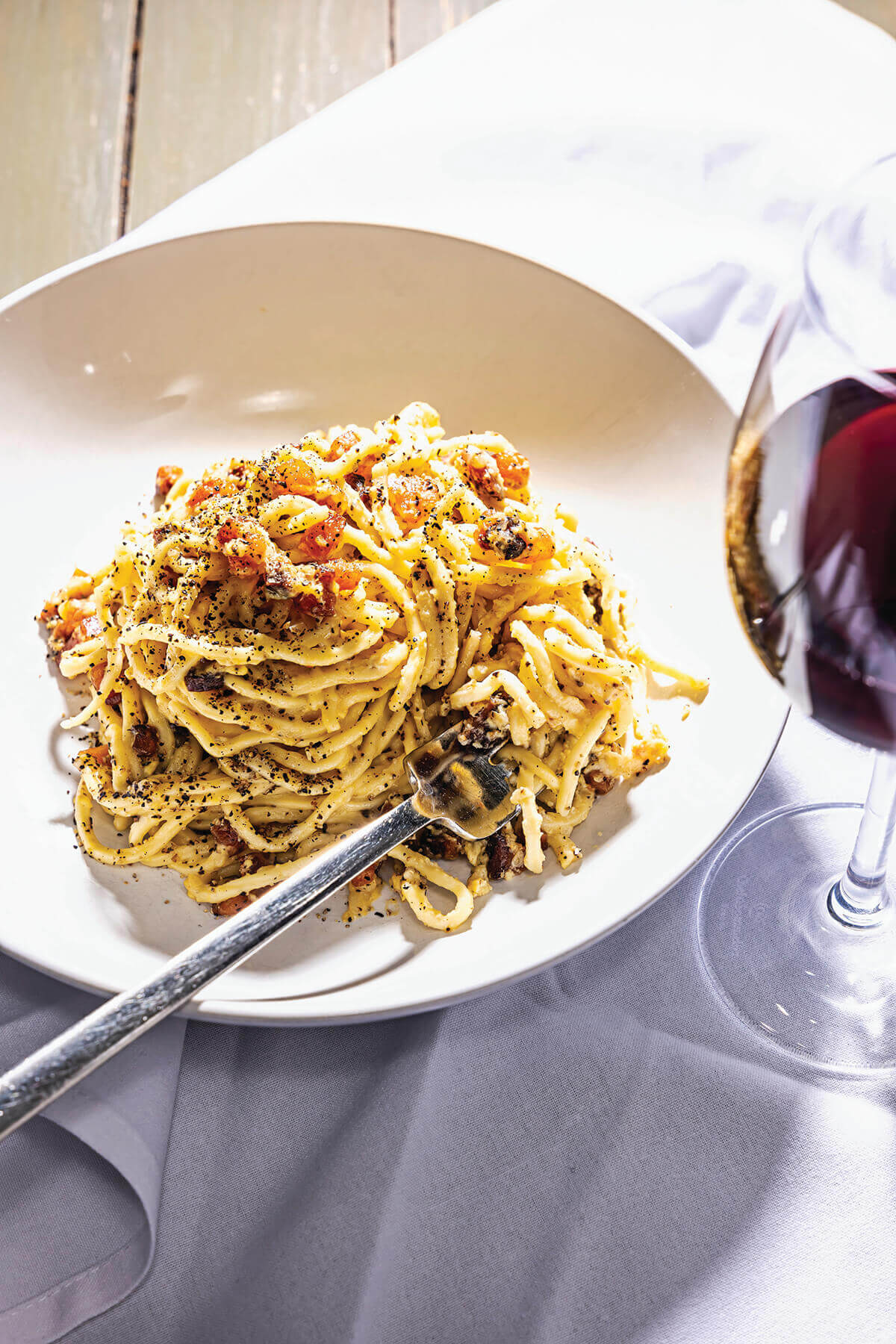
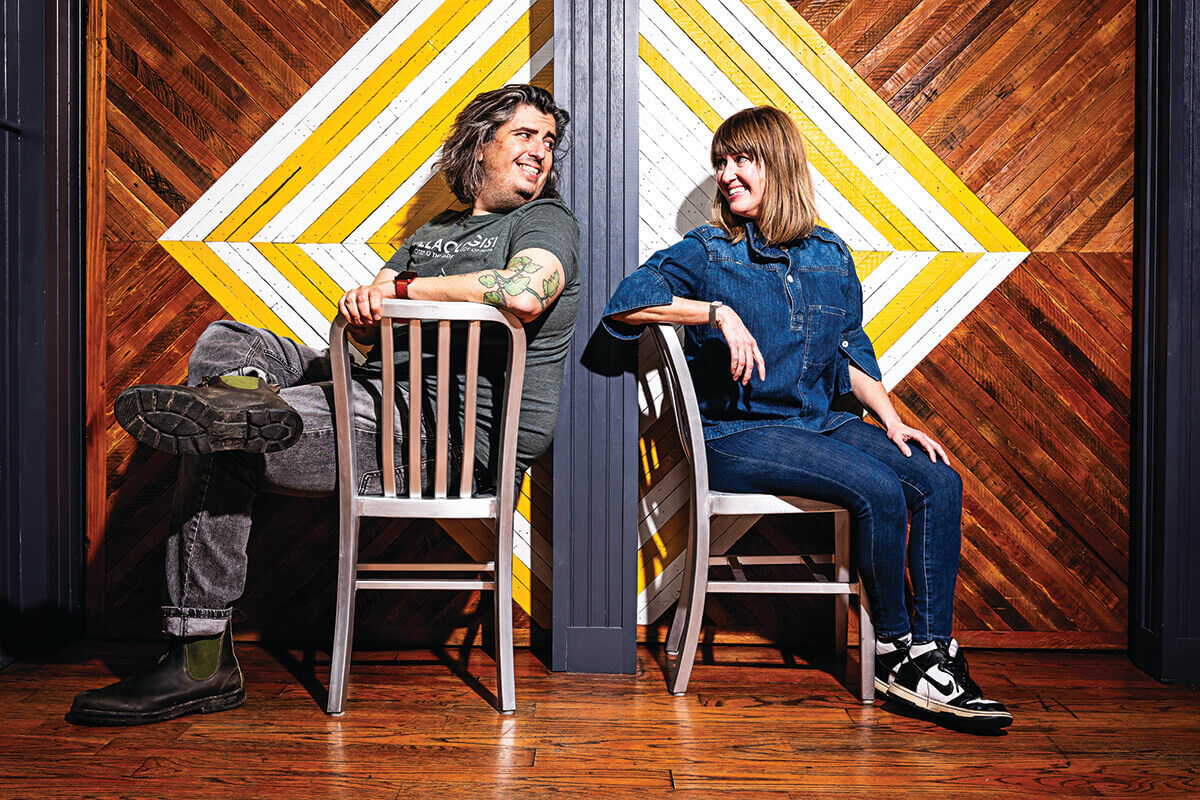
Kale and pistachio pizza and clam pizza; spaghetti carbonara; owners Josh and Stephanie Hershkovitz.
While a student at the University of Chicago, co-owner Josh Hershkovitz studied art and philosophy. Fortunately for us, he applies his education to culinary endeavors, with an emphasis on thin-yet-sturdy wood-fired pizzas and visually delightful pastas that are, indeed, thought provoking (as in we can’t stop thinking about them for days after downing them). From the fig-infused rye whiskey to the gnocchi, everything is made in-house, and no shortcuts are taken. Behold the bubbly crusted white pie that’s a clever combination of kale and pistachios, or the New Haven clam pie, a ringer for Frank Pepe’s legendary Connecticut creation. There’s also a spaghetti carbonara that tastes exactly like the versions we’ve eaten in Rome and seasonal items that astonish, like a late-summer corn pancake topped with Gulf shrimp. A visit to the humble Hersh’s feels like you’ve just joined the cool kids at the greatest neighborhood block party.
Food for Thought:
On their website, Josh and his co-owner-sister Stephanie promise Will Ferrell a free meal should he decide to stop by. (The siblings’ favorite movie is Anchorman.)
Limoncello
LOCUST POINT 900 E. Fort Ave.
Although the meatball is monstrous in size, its building blocks are humble. Like so much at this suave Southern Italian restaurant, the appetizer relies on the harmonization of its simple but quality ingredients—Kobe beef, mortadella, tomato rag, whipped ricotta—to create a delectable dish. This approach is found throughout the menu. Seared scallops topped with crispy prosciutto soar. Orecchiette pasta tastes as beautiful as it looks in the bowl, with crumbled fennel sausage and roasted garlic broccoli rabe. A plate of grilled shrimp, swordfish, calamari, and octopus allows the flavors of the seafood to speak for themselves. Speaking for ourselves, every time we leave this stylish and quite comfortable dining room, we’re already thinking about what we’ll order when we come back.
Food for Thought:
To make its namesake liqueur, the restaurant uses whole-grain alcohol—not vodka.
Linwoods
OWINGS MILLS 25 Crossroads Dr.
Thirty-eight years ago, Ellen Rothschild, then a political TV reporter in Richmond, and Linwood Dame, a Culinary Institute of America grad who owned a cafe, fell in love. Soon after, they were married and dreamed of opening their own restaurant, which they decided to do back in Ellen’s backyard of Baltimore. On an electric typewriter, they hatched a plan for an upscale spot with regional American small plates—and they named it Linwoods. Decades later, the concept remains the same—and this County gem remains a labor of love. Ellen works front-of-house, while “Woody” works in the open kitchen, mentoring his staff, putting the finishing touches on always-delicious seasonally inspired plates (butternut squash ravioli, crab gazpacho) and signature standards (tenderloin salad, scampi pizza). Linwood also eyeballs every dish before it’s sent into the sleek dining room, filled with loyal regulars who treat the spot as their de facto home away from home.
Food for Thought:
Linwoods' open kitchen was one of the first of its kind in the area.
Loch Bar
HARBOR EAST 240 International Dr.
Despite all the challenges that the restaurant industry has confronted lately, raw bars and seafood restaurants abound in our city—and we couldn’t be happier. Among our favorites is Loch Bar. Here you’ll find a tempting selection of raw oysters, towering sandwiches, and hearty main courses. The welcoming pub-like atmosphere and plush banquettes give the airy space a relaxed demeanor to complement a great view of the city waterfront. The menu reads like a casual seafood joint, but everything is elevated. The fish and chips features a succulent piece of rockfish without much batter, the lobster roll spills over with whole claws and generous amounts of tail meat, and the Chesapeake club sandwich is stuffed with enough shrimp salad and crab cake to feed two. Go early to nab a waterside booth for the total experience.
Food for Thought:
The marble surfaces were culled from a quarry in Vermont that was also used to build some Washington, D.C., monuments.
Maximòn
HARBOR EAST 200 International Dr.
The smell of the carne asada marinated in Peruvian soy sauce and chiles precedes its arrival. When the sizzling steak is wheeled to your table, a server uses scissors to cut it into smaller pieces, which are served with poblanos, onions, and housemade salsas. The wait is torturous, but oh so worth it. Whether mixed with rice and placed on terrific corn tortillas or eaten right off the plate, the dish is one of the best we’ve had in the city. Lots of other things on the menu of this bustling Latin-focused restaurant and lounge inside the Four Seasons are quite good—rockfish ceviche, grilled shrimp and crab tacos, and a side of potatoes with cured egg yolk, botija powder, and huancaina sauce among them.
Food for Thought:
Live music, often Latin jazz, is featured on weekend evenings. It’s sometimes followed by a DJ. Both provide a boisterous party atmosphere.
Monarque
HARBOR EAST 1010 Fleet St.
This dark and dramatic steakhousecum-cabaret sizzles with sex appeal, which is why a meal here is all about carnal pleasures. There are the cheekily named cocktails like the Ma Chéri and La Vie en Rose, the nimble Monarquette burlesque performers and a sword swallower, and a meat-heavy menu replete with steaks and chops, aged and prime. It’s all about decadence at Monarque, so other menu items, like the rich onion soup, succulent duck confit crepes, and a showy, three-tiered seafood platter stocked with shellfish, are also on offer. If dinner theater isn’t your thing, the restaurant books different musical acts on weekdays, including local vocalists and jazz and blues artists. Prices are steep, but the luxe space—with moss-green velvet curtains, rich rust-hued leathers chairs, and photos of burlesque dancers—invites lingering and looking and, of course, entertainment is included. Now, on with the show.
Food for Thought:
When he came up with the d cor, interior designer Patrick Sutton was inspired by Paris’s famed Moulin Rouge cabaret, Bob Fosse’s musical Cabaret, and SoHo’s Balthazar brasserie.


By Jane Marion
FREDERICK 228 N. Market St.
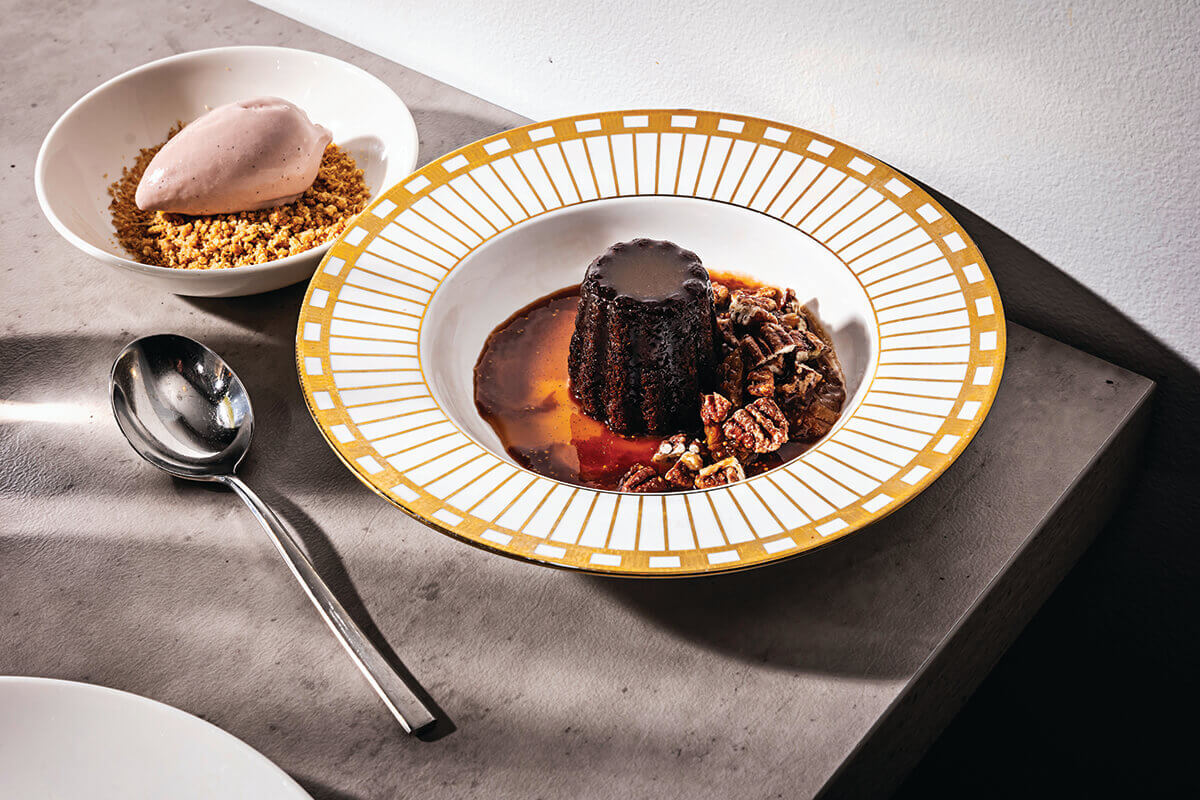
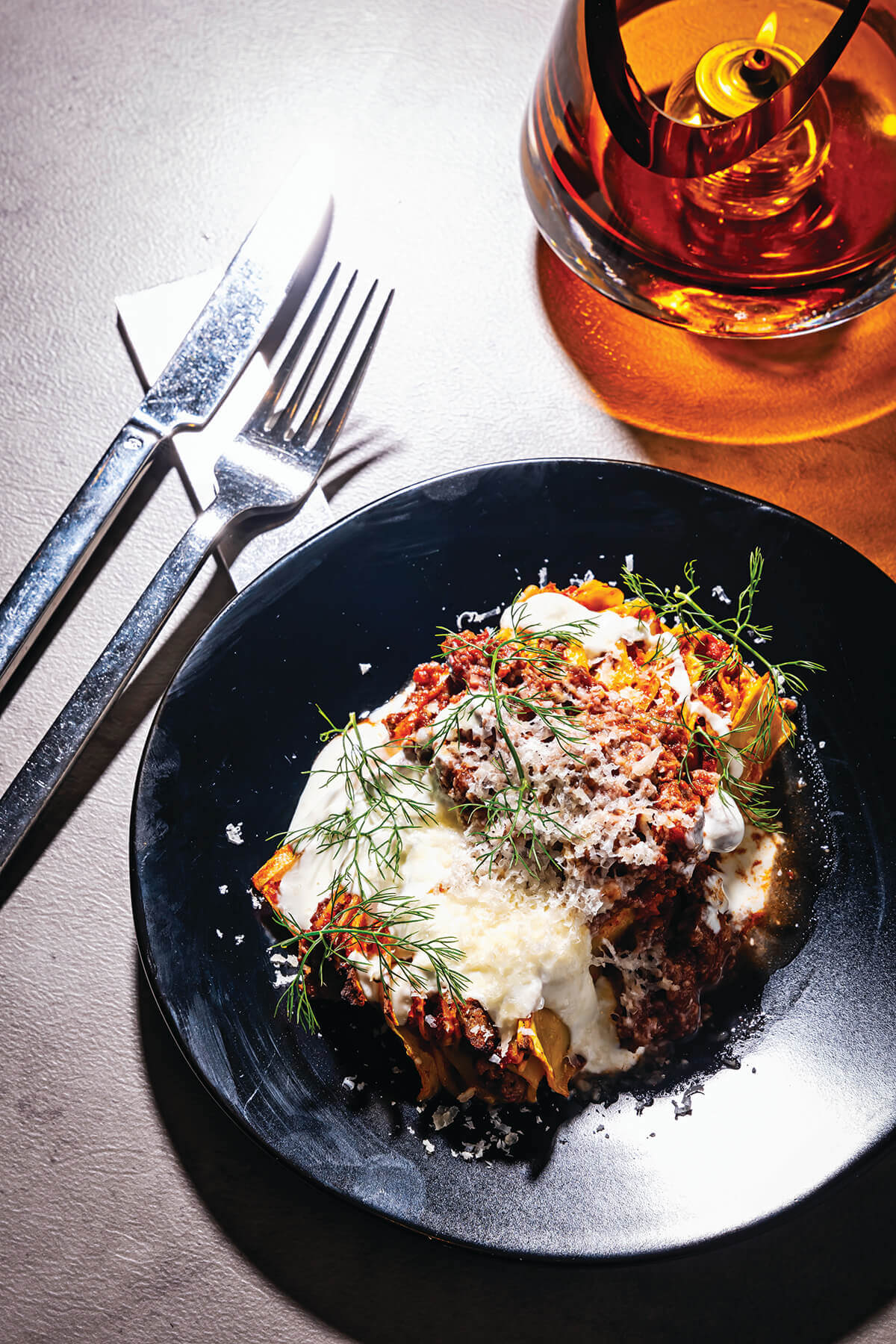

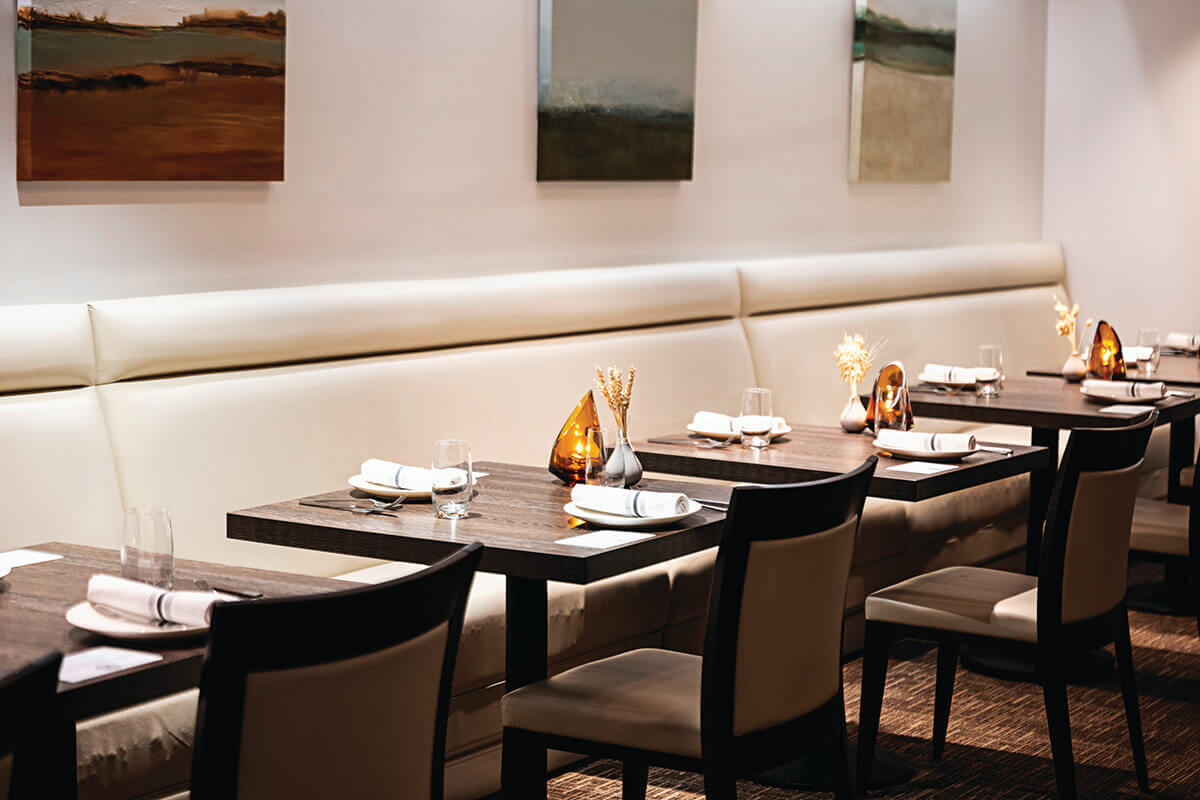
Sticky toffee cake; the lasagna; an Old-Fashioned cocktail; the dining room.
On an unseasonably warm December night, a family of four stands outside Frederick’s Thacher & Rye, contemplating the posted menu. As they peer into the peaceful dining room whose simple tabletops are adorned with nothing more than a candle and bud vases filled with dried rye, they decide to go inside. “This place looks really nice,” one of them says as they ascend the steps of the majestic 1890s brownstone. Prior to the pandemic, Thacher & Rye was Bryan Voltaggio’s famed Volt, known for its 15-course (or more), prix-fixe, modernist, molecular gastronomy tasting menu, delivered to the white-linen tables by a fleet of servers. Walk-ins would not have found a seat at the table. But that was then, this is now. Voltaggio was forced to shut down at the start of the pandemic. Since reopening, he has rebranded the space and crafted a more casual concept, one with fewer servers and more bar tables. “Volt got the reputation of being for celebration-only tasting menus,” says Voltaggio, who is also at the helm of the Voltaggio Brothers Steak House at MGM National Harbor with his sibling and fellow Top Chef contestant, Michael. “I knew that if we were reopening, it had to be a different experience. I also learned from Volt that three and a half hours is too long a dining experience—we don’t have that time anymore.” With Thacher (his first-born son) & Rye (a nod to Maryland’s history as the maker of rye whiskey), Voltaggio is hoping to draw passersby. “I’ve always wanted to connect with as many diners as I can,” he says. “That’s what I love about hospitality.” What hasn’t changed is how the chef sources. “We didn’t change the ethos of the restaurant,” says Voltaggio. “We’re trying to keep the ingredients within the Chesapeake watershed.”
Even without all the formalities, the dishes—from shrimp and grits to duck rillettes with buttermilk biscuits—are divine and prettily plated. And pasta, for the chef who is of Italian heritage, is still very much a signature. The lasagna, for instance, is 11 tissue-thin layers of handmade egg noodles stuffed with a pepperoni Bolognese and topped with ricotta fondue. “Years ago, I made a Bolognese with calamari,” says Voltaggio, explaining the inspiration. “It was a seafood-based sauce with a pepperoni sofrito. We’re just carrying on with that flavor profile. Making Bolognese is second nature to me.”
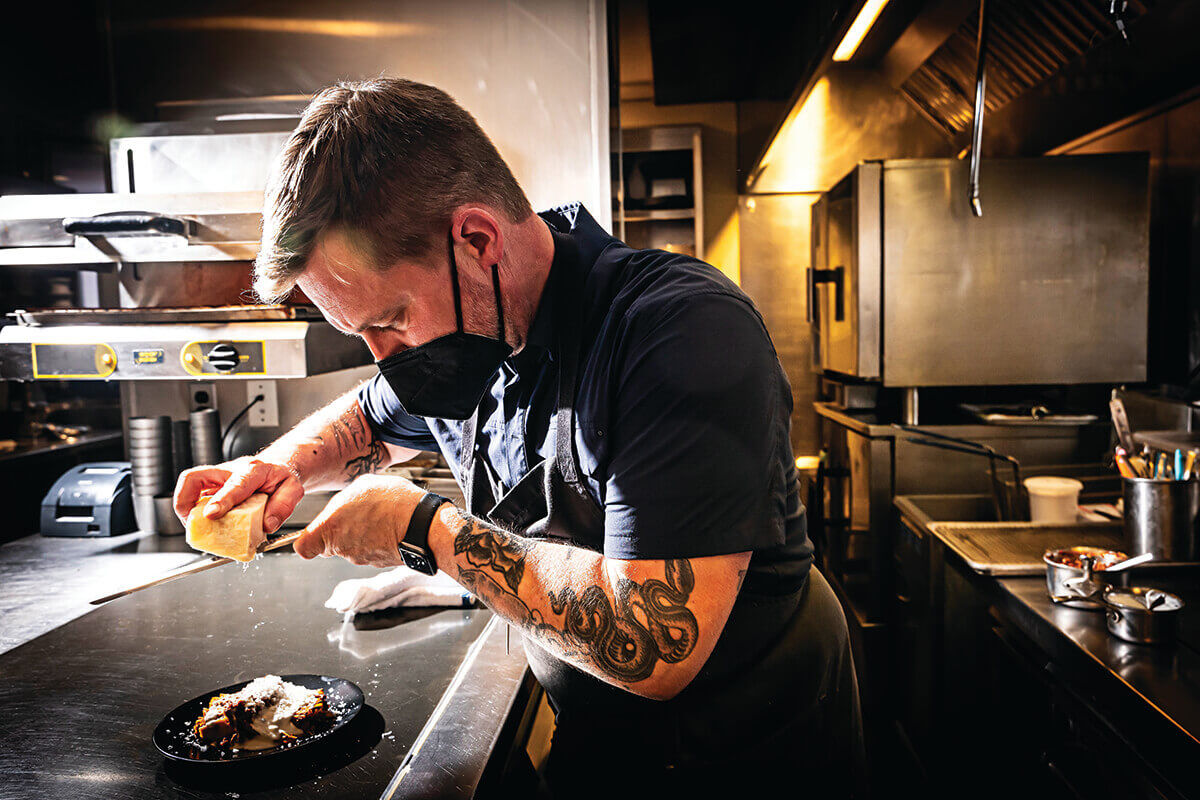
Chef Bryan Voltaggio at work.
After 25 years of standing over a stove, much is second nature for the chef. During the pandemic, when the restaurant was closed, he turned to farming his own nine-acre Frederick property. “I grew corn and root crops and different types of lettuce and had 100 tomato plants,” he says. “I had so much stuff, I let my kids set up a farm stand and sell it for extra cash, and I gave away product to friends and chefs in Frederick.” With the restaurant now open, still in the heart of charming downtown Frederick, Voltaggio is continuing to farm on a smaller scale, using much of what he grows for the menu, but he’s also on to his next adventure. “I’m taking classes to get a private pilot’s license,” he says. “I wanted to do something that was out of left field where I could just disconnect.”
Given his track record, he’ll be soaring in no time.
Ouzo Bay
HARBOR EAST 1000 Lancaster St.
With its neon and blue hues shimmering from the street, this Hellenic hotspot is a beacon in Harbor East. Inside, an ocean of excellent chargrilled offerings awaits, from fish flown in from around the world (Norwegian langoustines, Dover sole from Holland) to more composed plates including a caper-crusted swordfish and sea scallops with braised lamb marmalade. Feel like sharing as you move through your meal? Skip the entrees and enjoy a round of seafood mezedes and crudos or classic Greek apps like the showstopping flaming saganki or tender lamb meatballs tossed in tomato sauce and showered with feta. The vibe is ritzy, the cocktails are refreshing, and the alfresco dining area offers one of the best views of the Harbor. When Ouzo opened 10 years ago, it kicked off the nightlife scene in Baltimore’s swankiest zip code. The party is still going strong.
Food for Thought:
In 2019, Ouzo Bay welcomed a sister spot in Houston by the same name.
Papi Cuisine
RIVERSIDE 2 E. Wells St.
Since opening in its new location last May, chef Alex Perez’s Afro-Caribbean-Latin-fusion restaurant has established itself as one of the most fun spots in the city. Everyone here—the greeter out front, the bartenders, the servers, and, most importantly, the customers—always seems to have a smile on their face. And why not? Papi’s menu is playful and decadent. The crab cake egg rolls are a legend in the making. You can order honey-glazed salmon or lobster with a crab cake stuffed inside. Or maybe you should have that lobster tail deepfried? Mac and cheese is made with four cheeses; it’s deliciously gooey, and impossible to stop eating. Take a sip of one of Papi’s cocktails, like the Paradise, made with rum, mint, pineapple syrup, and garnished with pineapple, and you’ll feel like you’re on vacation. Dinner at Papi Cuisine might be the next best thing.
Food for Thought:
The Papi’s Pineapple rum punch is served in a whole pineapple and spouts dry ice.
Peerce’s
PHOENIX 12460 Dulaney Valley Rd.
Dining out is all about being cared for at the family-owned Peerce’s. Brothers (and co-owners) Keir and Binda Singh treat you like kin, as they, along with host-with-the-most Travis Wright, warmly greet customers by name at the door and make sure all your needs are met. Every dish on this menu highlighting modern Punjabi fare is a stunner—close your eyes, point to anything, and you’ll be pleased. You can’t go wrong, from the exquisite almond-crusted lamb chops to the whole pan-fried Goa fish with roasted garlic, tamarind, and scallions. Expect to find New-American, Maryland-style spins on the menu, too, like the seasonal soft-shell crabs, panfried with coconut, rice, and toasted mustard seeds, or the divine Kerala crab cakes with cumin and mustard seeds as a stand-in for Old Bay. If you’re gluten-free or vegan, there are myriad options, too. All of this is against a backdrop of chocolateand-gold-accented dining rooms with laser-cut lanterns gracing every table, plus the most glamorous alfresco setting around, and it’s no wonder this place became an instant sensation.
Food for Thought:
The historic 1930s property started as a chicken stand known as Peerce’s Corner.
Petit Louis Bistro
ROLAND PARK 4800 Roland Ave.
When longtime Petit Louis chef Chris Scanga left Foreman Wolf’s French fare institution to head up the kitchen at The Milton Inn, and then senior sommelier Marc Dettori announced his retirement, all we could think was, “Mon dieu!” We worried needlessly, as the reins were handed over to executive chef Mario Cano Catalán, who was previously at the helm of the restaurant group’s now-closed Bar Vasquez, and has slid seamlessly into the kitchen, quickly mastering the menu of bistro classics (a proper pâté, a mile-high quiche Lorraine, a burnished whole chicken roasted in duck fat). As always, maître d' Patrick Del Valle, who hails from Lyon, France, gives the place a proper French accent. While eating inside the Belle Epoque-style dining room is always a total treat, we also adore the pandemic-proof tent that was erected for ample dining en plein air. Wherever you sit, enjoy a glass (or bottle) of wine from the extensive French wine list. While staff members may come and go, our love for Louis will last forever.
Food for Thought:
Petit Louis is in the oldest strip mall in America, dating back to 1897.
Preserve
ANNAPOLIS 164 Main St.
Historic Annapolis boasts some of the oldest restaurants in the state (Middleton Tavern, founded in 1750, is one of the oldest in the country), but this seven-year-old relative newcomer, at least by Naptown standards, is also one of the best. Owned by husband-and-wife Jeremy and Michelle Hoffman, the sophisticated spot on bustling Main Street has a dedicated pickling and preserving program. Elements of each show up across the menu. Crisp cucumber pickles appear alongside a phenomenal smoked fish dip with house-made crackers and vinegary red onions glisten atop the signature crispy kale. But the practice of preservation, which inspired the restaurant’s name, is more than a clever concept. There’s also an emphasis on homespun comfort foods such as fish and chips and chicken-stuffed agnolotti. Of note, the service, sometimes in short supply these days, is impressively warm and welcoming. Preserve doesn’t take reservations, so gear up for a wait with a drink in hand, while you linger on the sidewalk. It’s all part of the experience.
Food for Thought:
Co-owners Jeremy and Michelle Hoffman met at the fabled Culinary Institute of America.
The Prime Rib
MT. VERNON 1101 N. Calvert St.
This venerable 57-year-old throwback is all about ambiance—until you taste the steak. Then it’s about ambiance and food. From the moment you walk through the door, you’re treated like royalty. The bar is almost always full, so take a seat in the dark dining room, filled with the sound of jazz piano. Always start with an order of the famous Greenberg potato skins and don’t be shy about dunking them in the horseradish sauce. The menu includes the requisite pork, chicken, fish, and shellfish of a classic chophouse—much of which is quite good—but it’s almost sacrilege to order anything other than the prime rib. The 14-ounce signature cut is a beautiful piece of meat, but the 30-ounce bone-in full cut is otherworldly. We’re not sure even famed competitive eater Joey Chestnut could finish it. But we do love trying.
Food for Thought:
The restaurant’s 14-ounce cut of prime rib, which now costs $46, once went for $4.95.
Puerto 511
DOWNTOWN 102 W. Clay St.
There were moments during the lockdown, amid Baltimore City’s reluctance to reopen restaurants, when chef Jose Victorio Alarcon considered leaving the kitchen for good. Thank goodness he prevailed, and his cooking hasn’t missed a beat since Puerto 511’s return to seated dining service in the summer of 2021. He continues to craft stylish plates with flavors inspired by his Peruvian homeland. If you have not yet been, make it a point to experience the reservations-only, prix fixe menu offered every weekend. You’ll be rewarded with a dinner that spotlights freshness, vibrant citrus flavors, and thoughtful presentation. A noteworthy bonus is that Puerto 511 is BYOB, so pick up your favorite Malbec on the way. Or bring along a batch cocktail—may we suggest a pisco sour—to kick off the evening.
Food for Thought:
Alarcon and his wife, Connie, also own Andina, a phenomenal grab-and-go empanada spot, on Lexington Street.


YOU NEVER FORGET YOUR FIRST FINE-DINING EXPERIENCE.
By Jane Marion
ILLUSTRATION BY JAMES ALBON
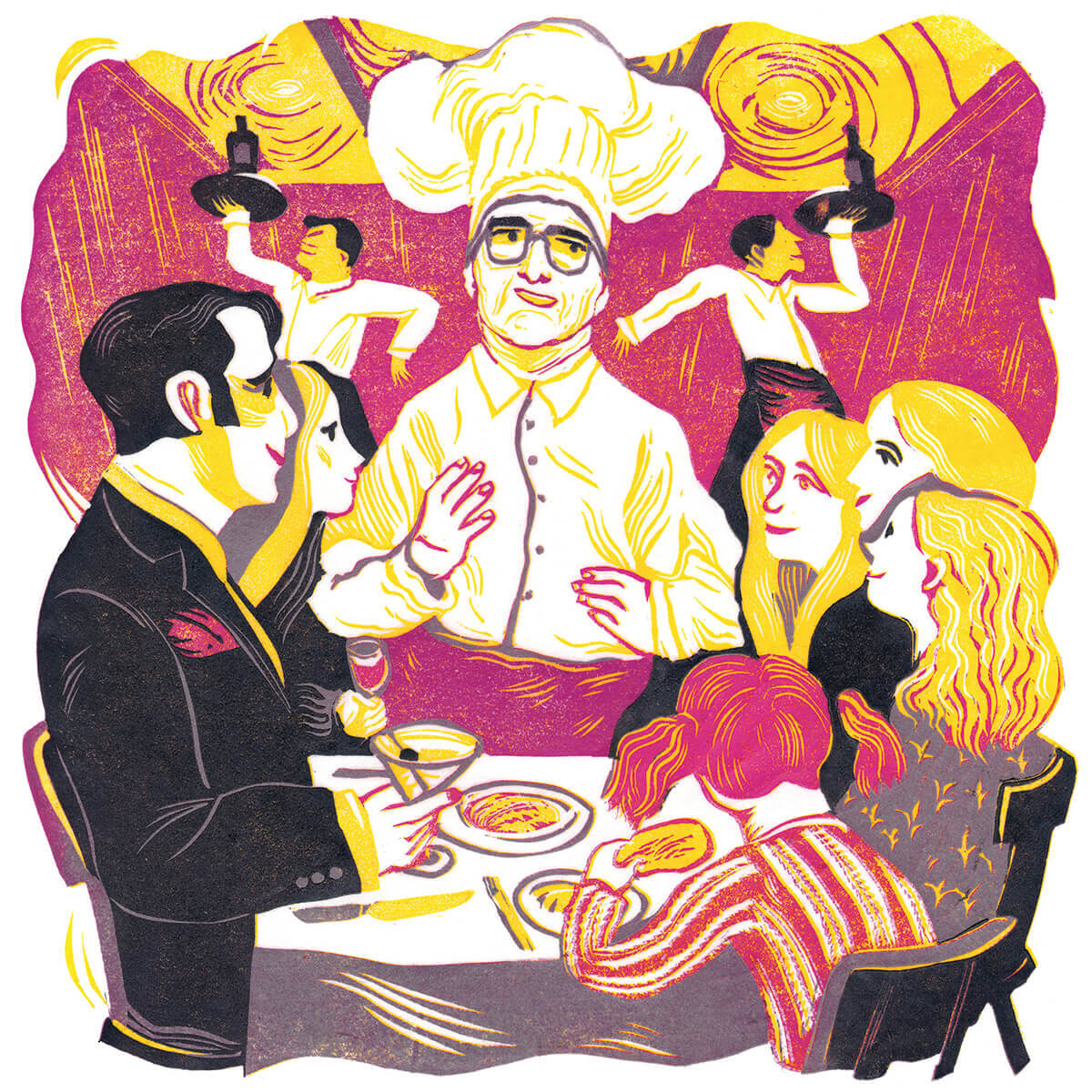
My earliest restaurant memory takes me back to the sprawling dining room of Manero’s Steak House, an institution in Greenwich, Connecticut, where I lived as a kid. In the early ’70s, as our family of six piled into a wood-paneled Country Squire, my parents took the restaurant’s motto—“always bring the children”—to heart. (One of their other, albeit dated, mottos was, “Thru these portals pass the most beautiful steaks and women in the world.”) About once a month, on a Saturday night, we gathered around one of the wood tables at Manero’s. While my sisters squirmed, I stared. The family-style Gorgonzola salad was our standing appetizer order—and it was legendary. One server (we called them waiters back then) carried the big wooden bowl and held it in place, while another took tongs as big as boat paddles and plated the greens, coated in creamy dressing and topped with fried onions. As we waited for our steaks to arrive, I pinched pieces of warm garlic bread from the complimentary basket and bit into the gin-soaked onions my father slipped me straight out of his martini. At Manero’s, on your birthday, a quartet of waiters brought out a cake and sang “Happy Birthday” in staccato. And best of all, the restaurant had a sign on the wall that said if a baby was born in the restaurant, he or she would get free steaks for life. Though I never saw it with my own eyes, I imagined that a very pregnant woman or two must have at least tried taking them up on that offer. Along with the rest of us, celebrities like Andy Rooney and Arnold Palmer would line up for filet mignon dinners, including an appetizer, coffee, and dessert, for $5.95. (According to press reports, they sold some 1,000 steak dinners a night.) Inevitably, between the salad and our steaks or scampi, the chef, Nick Manero, would wander around the room in his starched chef’s coat and tall, trademark toque. I felt special whenever he graced our table. In addition to being a bit of a celebrity himself, I was certain that he was a magician, because our meal would always appear while he was still standing at our table.
In 1980, long after we moved out of state, Mr. Manero (never chef Manero) passed away. His family carried on his legacy for a little while longer, but after 62 years, the restaurant eventually ended its run. It’s been 49 years or more since I ate at Manero’s, and, yes, times have changed (who serves garlic bread anymore?), but it was never about the food. Manero’s is where I first felt the thrill of what it meant to eat in a restaurant, which felt distinctly different from the meals, well-intentioned as they were, that my mother served at home. It set the standard. It’s where I learned good table manners. It’s where I developed a taste for Shirley Temples (and eventually, martinis, thanks to those cocktail onions). It’s where I was given agency to make my own decisions about what was for dinner (read: none of mom’s meatloaf). And, best of all, it’s where I learned to love the pomp and circumstance, the sheer fun and fanfare that comes with a night out on the town. Even then, I knew that we were privy to something sophisticated and special—and lucky to tag along at a time when kids mostly stayed home. I wasn’t born at Manero’s, though that would have been pretty prescient for a future food critic. But eating there did mark the beginning of a birth—it’s the place where my lifelong love affair with restaurants started. And I knew that even without free steaks for life, I’d find my way back, if not there, then somewhere just like it.
Restaurante Tio Pepe
MT. VERNON 10 E. Franklin St.
It would have been easy for Emiliano and Miguel Sanz, distant cousins and longtime co-owners of this 53-year-old Spanish subterranean staple, to call it a career when COVID-19 dealt its near deathblow to so many restaurants. Lucky for us, they soldiered on. When we returned for the first time in two years, we were—as always—delighted by how little had changed. Laughter echoed throughout the dining rooms, some of it undoubtedly fueled by the signature red sangria. We resisted the urge to order the legendary paella and instead tried the Pargo a la Vasca, aka red snapper with clams, mussels, asparagus, and boiled egg, and the Pollo a la Riojana—chicken saut ed in olive oil with peppers, tomatoes, and mushrooms. Both were excellent and had us vowing that it won’t be two years until we dine here again.
Food for Thought:
During a busy week, the restaurant sometimes serves more than 150 pitchers of sangria.
Royal Taj
COLUMBIA 8335 Benson Dr.
This swanky Indian restaurant gets your attention with its sumptuous décor—recessed ceilings outlined in gold, a massive crystal chandelier, marble fireplaces, and floral-brocade chairs—but it’s the small things that stick with you. Like the rice: Our genial server dished out fluffy basmati, then quickly disappeared, only to return with another mound. (Our to-go boxes also came equipped with more of the staple.) But really, the niceties start with a basket of complimentary papadum (thin, crackly lentil bread), followed by an array of expertly prepared traditional appetizers and entrees. You can dabble in bites, like a minced lamb samosa or a pile of rosemary naan, even better when dunked into raita, then saunter into main dishes, like a spicy chicken vindaloo and luscious lamb korma with a coconut-almond-cashew sauce. Even on busy nights, the pace at this dining spot is never rushed as you indulge.
Food for Thought:
Royal Taj’s teak furnishings are custom-made and imported from India.
Sotto Sopra
MT. VERNON
405 N. Charles St.
It’s hard to believe that this charming Italian restaurant celebrated its 25th anniversary last year. We admit that we sometimes take it for granted, which is a mistake we’re reminded of every time we eat here. A meal starts with house-made focaccia and premium olive oil that hints at the simple, classic fare to follow. On a recent outing, we devoured a bowl of light and luscious gnocchi topped with Parmesan and a naturally sweet tomato sauce. A branzino filet was delicately prepared. The crunch of the fish’s crispy skin combined with the tender meat to make each bite a treat. With stellar service, a wonderful wine selection, and cooking that never disappoints, we know we’ll be back again.
Food for Thought:
Once a month, the restaurant hosts an opera night with live music and a five-course dinner for $85 per person.
Tagliata
HARBOR EAST 1012 Fleet St.
There’s a reason why this Harbor East Italian restaurant is one of the most besieged in Baltimore. With its velvet banquettes, string-lit courtyard, and sophisticated piano bar, the place is sexy as hell, but ambiance can only go so far. What makes “Tag” so terrific is easy to answer—the draw is the cooking of its executive chef-partner, Julian Marucci. For the past five years, day in and out, Marucci has come up with devastatingly delicious dishes, from seasonal plates, like a late-summer smoked duck with plums, to the restaurant’s superb selection of steaks and chops—not to mention the very best examples of Boot Country standards (don’t dismiss the delish chicken Parm). Handcrafting pasta, be it lobster ravioli or squid ink campenelle, is Marucci’s first love, and to watch him as he rolls, stretches, and spins various shapes is like watching a professional athlete at work. Of course, Tag is more than just Marucci; bow-tied managing partner David Goodman doubles as the consummate maître d', tending to your every need, including helping you navigate the 1,000-plus-label wine cellar.
Food for Thought:
The restaurant sells 35,000 meatballs a year.
Thames Street Oyster House
FELLS POINT 1728 Thames St.
This veteran fine-dining seafood spot is nestled among the historic waterfront buildings in Fells Point. At Thames Street, you’ll find a kitchen absolutely dedicated to flavor and freshness. Begin your experience with the raw bar, where you’ll find a rotating selection of the country’s finest shellfish, including raw clams. The main menu features succulent small plates, like a shrimp ceviche that packs the zing of citrus and the heat of Central American chiles, as well as creamy clam chowder. The crab cake is 100-percent Maryland blue crab and among the best we’ve ever tasted, while plump gnocchi finished in Madeira-lobster sauce provide a decadent bed for the slow-roasted monkfish. Drinks are sophisticated and the wine list is thoughtful. Thames doesn’t take reservations for parties over four and there’s rarely room for walk-ins.
Food for Thought:
The raw bar and cocktails are available between lunch and dinner service.


TOWSON 1 Olympic Pl.
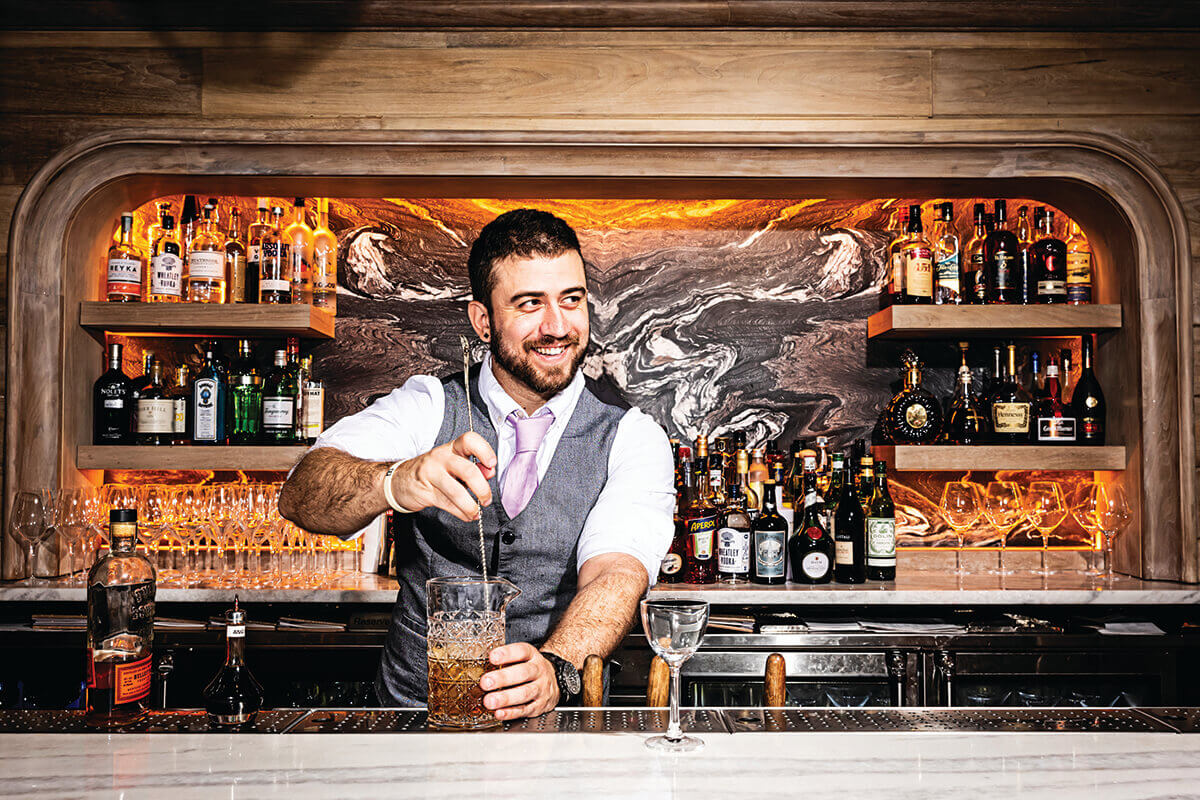
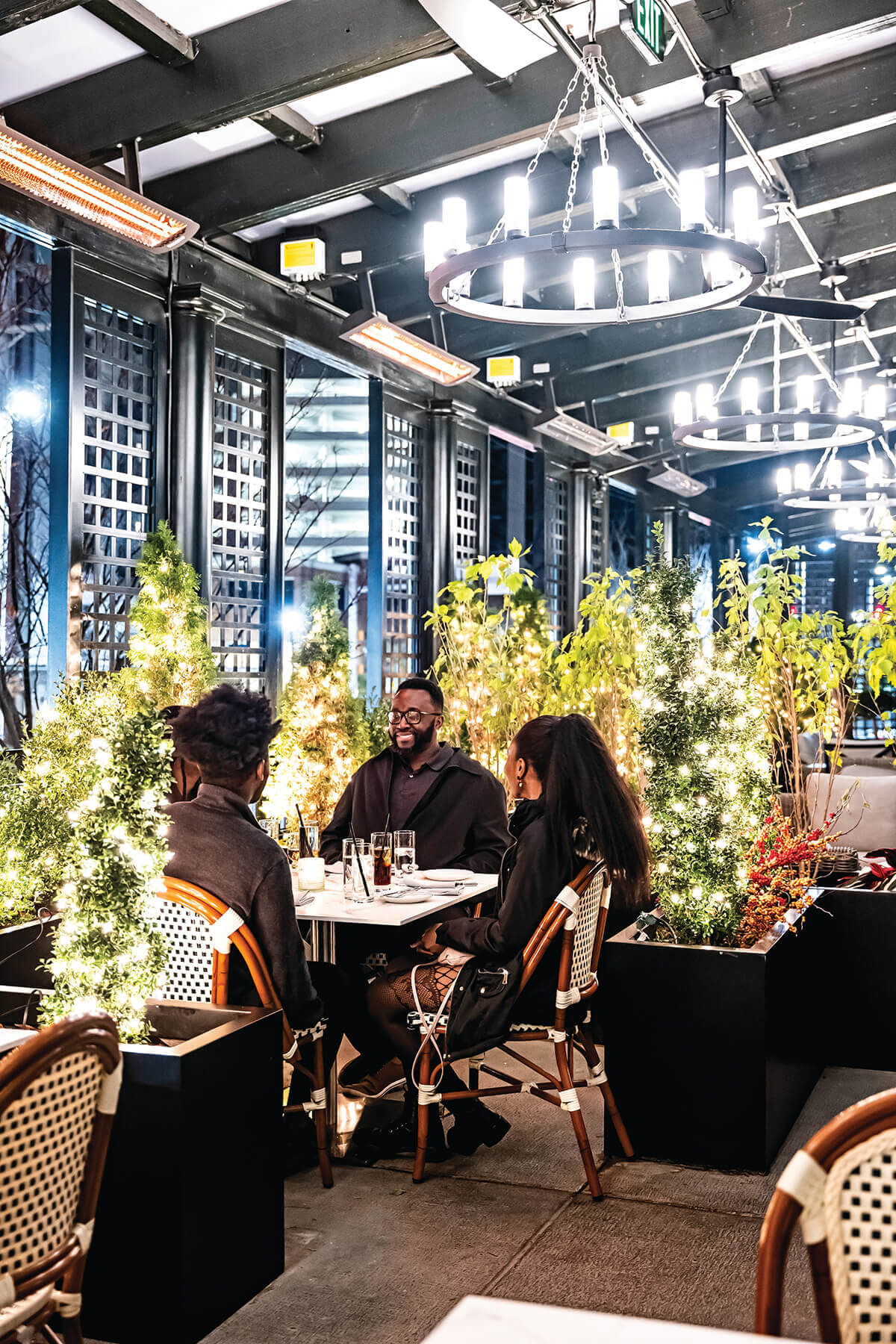
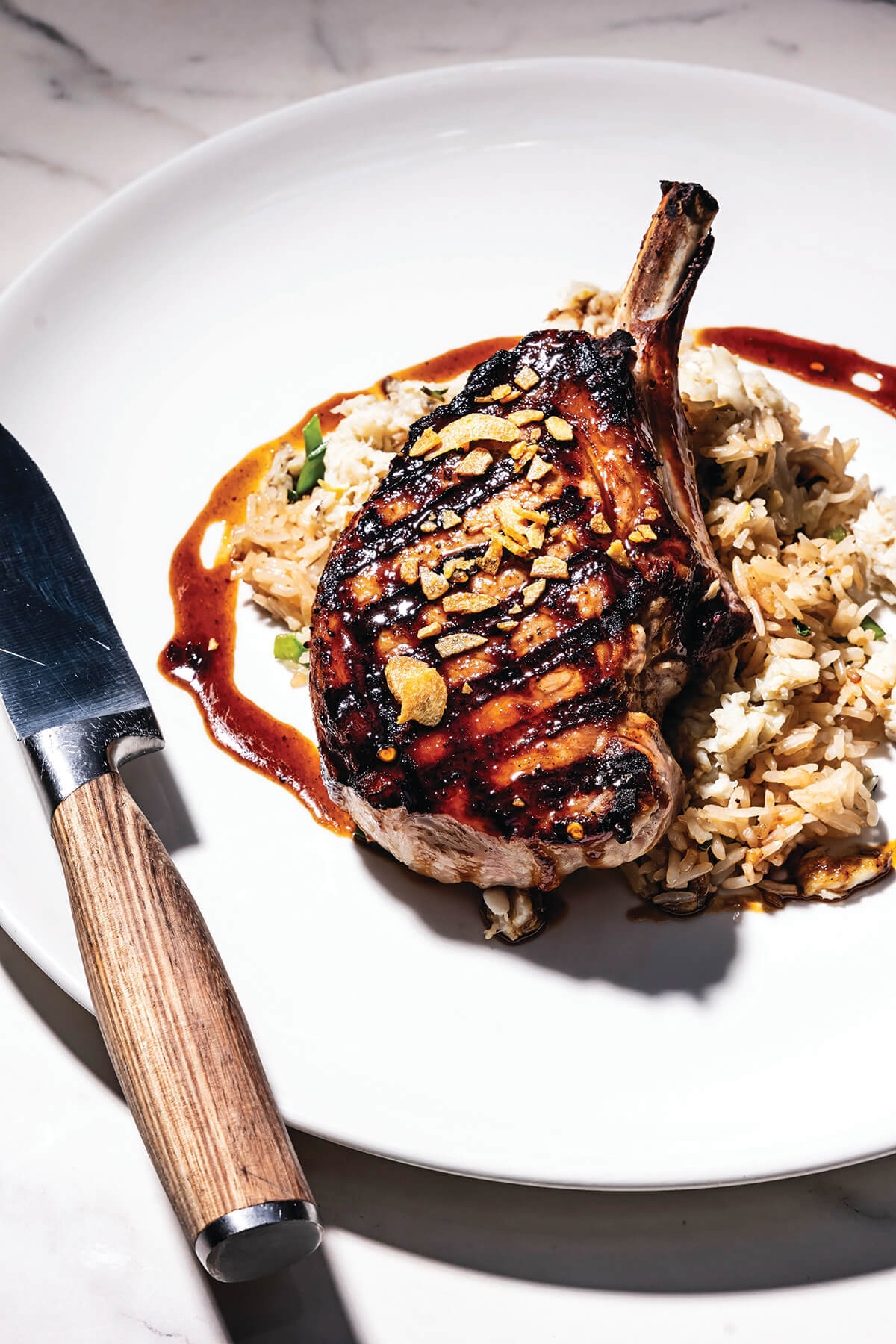
Bartender Noah Lorup; alfresco dining; Pork chop with blue crab fried rice.
This fine-dining newcomer—the Atlas Restaurant Group’s first foray into the suburbs—has given the sleepy county scene a much-needed jolt. (Even in a pandemic, reservations go well past 8 p.m. on a Saturday night.) On any given evening, there’s live music, a buzzy bar, diners dressed to the nines, and endless orders of fried lobster with honey butter and lavender salt flying out of the kitchen. And for good reason. Chef Jay Rohlfing, who was mentored at Linwoods, has clearly mastered the art of seasonal cooking, as displayed in a dish of tuna crudo with watermelon and red chili on a summer’s visit, or a bowl of pumpkin cider soup with bourbon meringue crisps in early winter. It also helps that the space, intimate and chichi, with a spectacular wraparound patio, is a perfect complement to the food.
Food for Thought:
The name of the restaurant was inspired by the chef’s own threeacre garden in Hampstead, where he grows scallions, strawberries, and squash.
The Tilted Row
BOLTON HILL 305 McMechen St.
Ziad Maalouf’s inviting eatery is the kind of neighborhood bistro everyone wishes was on the corner of their block. It has a little something for everyone. Mediterranean offerings, like the Moorish eggplant appetizer and blackened Moroccan salmon entree, all burst with complex flavors and authentic ity. Want American comfort food? Deviled eggs, a pimento cheese-topped burger, and mac and cheese, cooked so delicately you can twirl the noodles and watch as strings of hot cheese wrap around them, will warm most souls. The vegetarian wild mushroom polenta is as rich and satisfying as any dish on the menu, which includes steak frites and a pork chop. No matter your taste, everyone will appreciate the restaurant’s stellar service and yearn to return, even if you don’t live in the ’hood.
Food for Thought:
A different entree is featured as the Blue Plate special on Tuesdays through Thursdays, dessert included.
True Chesapeake Oyster Co.
HAMPDEN-WOODBERRY 3300 Clipper Mill Rd.
It doesn’t get more Chesapeake Bay-to-table than this shellfish Shangri-La, which serves oysters it raises on its own Southern Maryland aquafarm. The signature varietals—Skinny Dippers, Chunky Dunkers, Huckleberries—vary in size and style but all exude similar freshness. They’re incredible raw and roasted with herb-Old Bay butter. Clams, mussels, and shrimp are also on offer, but chef Zack Mills shows his range with non-seafood dishes, too. Chief among them when we visited was the chickenfried snakehead. An invasive species that harms the local ecosystem, Mills has turned a problem into an asset. Served with Swiss chard, brown-butter grits, pickled hominy, and a hot honey sauce, the dish is Southern comfort food at its best. Meanwhile, the star of the cast-iron-seared top sirloin wasn’t the meat (which was excellent), but the maitake mushrooms and peaches in an apple butter marinade. With a top-notch cocktail program and its beautiful environs, True Chesapeake is a true gem.
Food for Thought:
The bar top is made from real oyster shells.
Vin 909 Winecafé
ANNAPOLIS 909 Bay Ridge Ave.
On most days, you can count on a line forming outside this adorable, no-reservations bungalow-turned-restaurant before the doors open for dinner. It’s been that way for a decade. Diners want first crack at the prized seats, inside and out, to sample the chef’s carefully curated California-Mediterranean-inspired menu. Highlights include crisp brick-oven pizzas, like the Spotted Pig with wild-boar meatballs and soppressata, and shareable plates like a cast-iron skirt steak bathed in a spicy Moroccan sauce that warms from the inside out. Of course, wine is a star, with offerings for all, from $6 glasses ($22 bottles) assuring imbibers that “value is not a dirty word” to $12 glasses ($45 bottles) for their “damn-the-economy, let’s-drink-wine” mentality. We’ll drink to that.
Food for Thought:
Vin 909 sells more than 60 wines by the glass.


COLUMBIA 8850 Columbia 100 Pkwy.
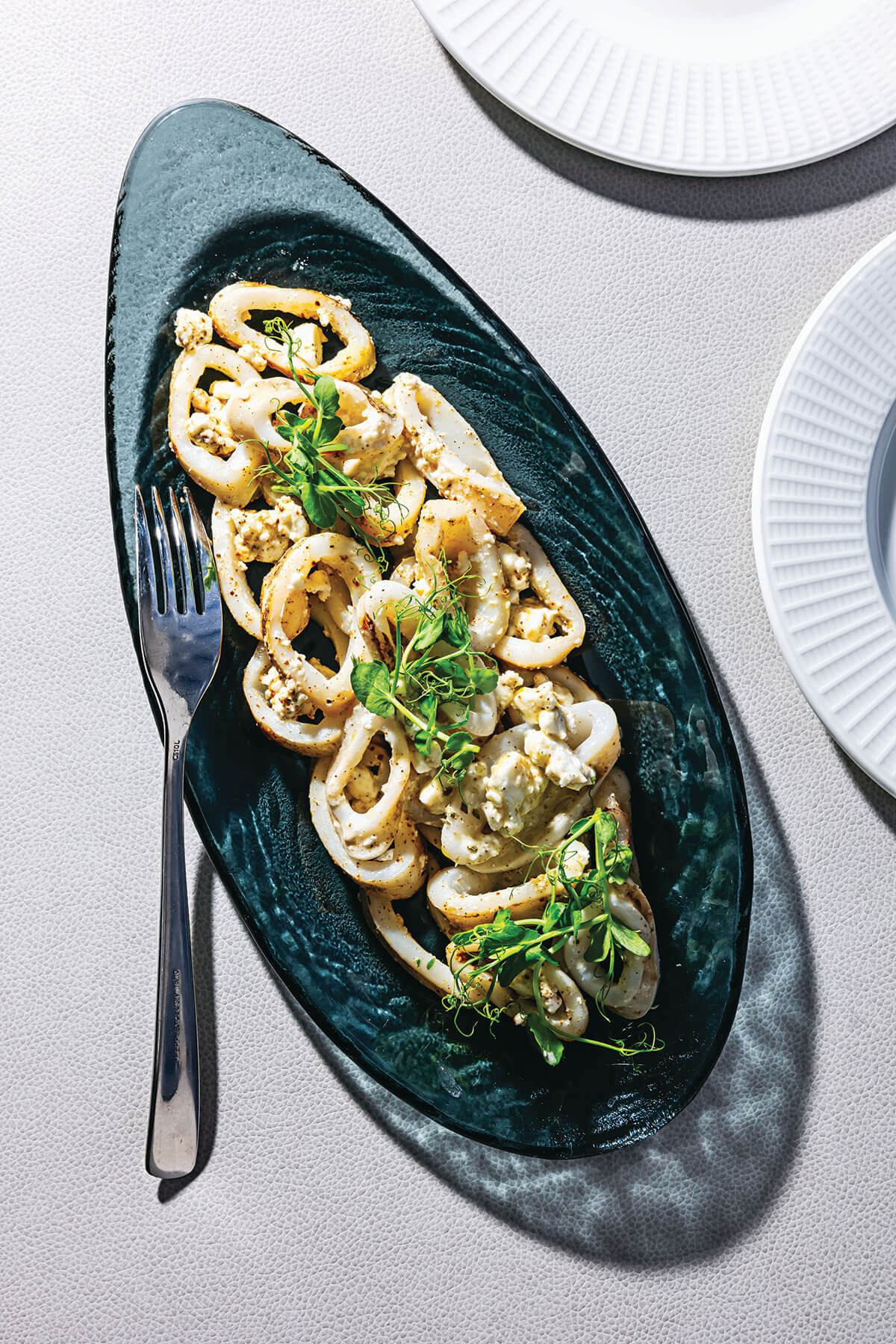

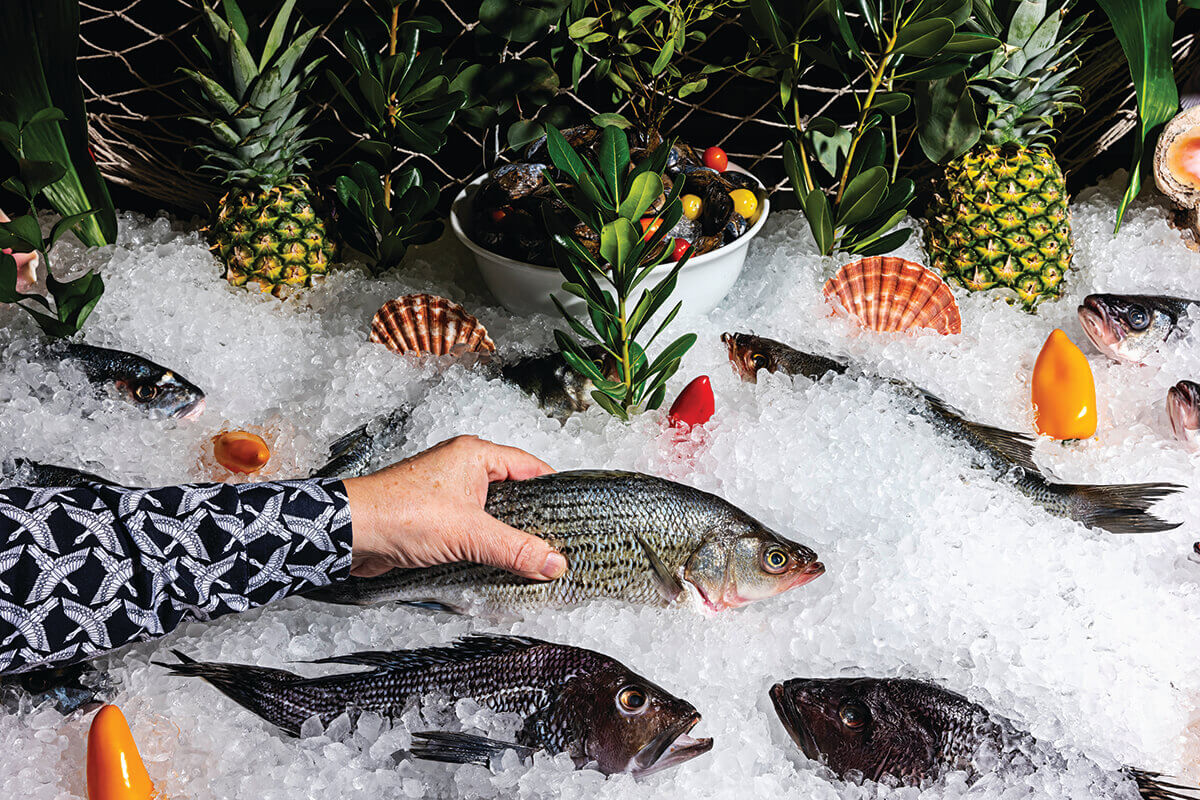
Calamari appetizer; owner George Aligeorgas; the fresh fish display.
Howard Countians may know about Xenia, but it’s time for the rest of the metropolitan area to learn about this fine-dining stunner. The restaurant, owned by George Aligeorgas, will remind Baltimore visitors of Ouzo Bay in Harbor East, of which Aligeorgas was a founding partner. The décor is elegant, with hand-blown glass fixtures, Aegean blue overtones, and a display case showcasing whole fish. Its menu focuses on Greek fare and just-caught seafood. A popular appetizer, the flaming cheese saganaki, sets the stage for the rest of a meal, which can include stuffed grape leaves and macaroni-beef pastitsio and fabulous fish, which the kitchen grills, debones, and presents at the table drizzled with a lemon-infused sauce and capers. Desserts like baklava are available, but every table receives complimentary Greek doughnuts, glistening with honey. Word’s out. Make your reservations now.
Food for Thought:
Executive chef Akis Anagnostou, 39, started working in his father’s pastry shop in Greece when he was 10. He uses his family’s recipes at the restaurant for dishes like moussaka and spanakopita.


